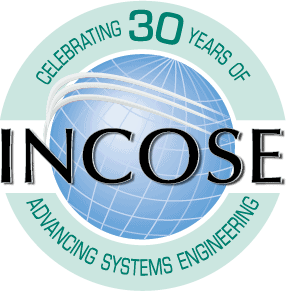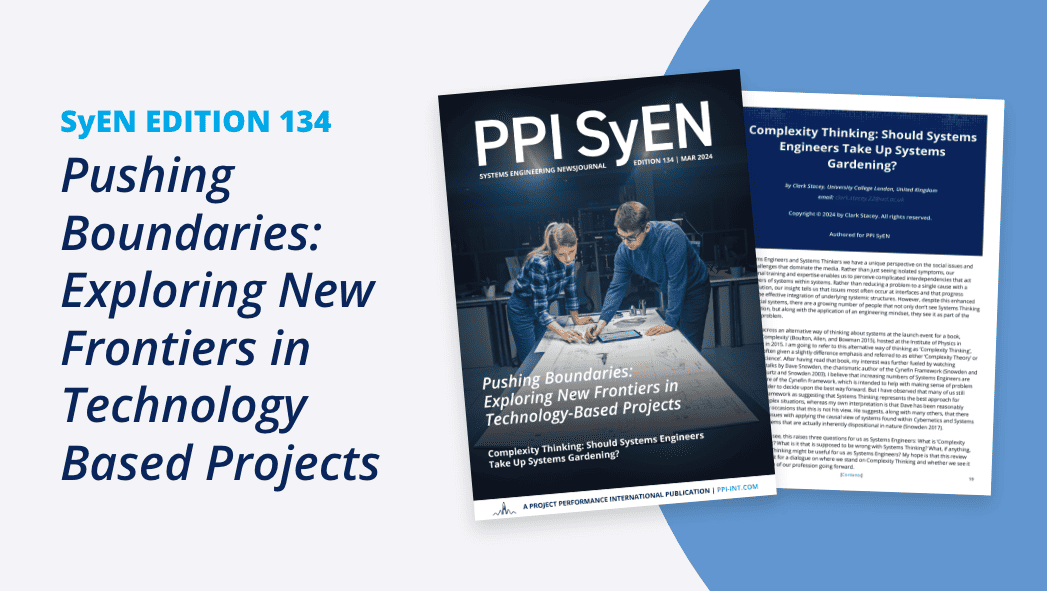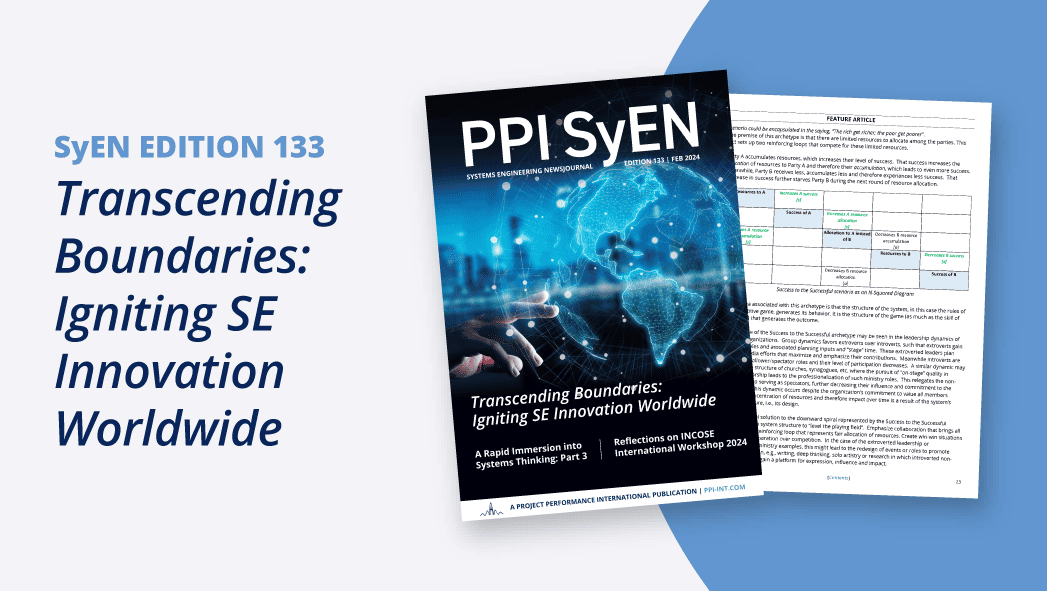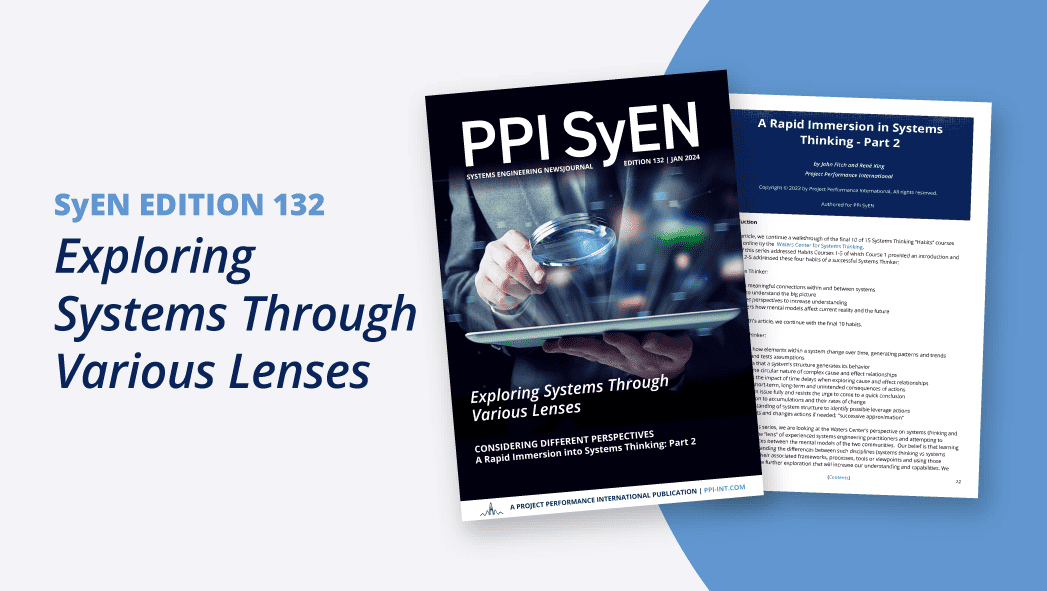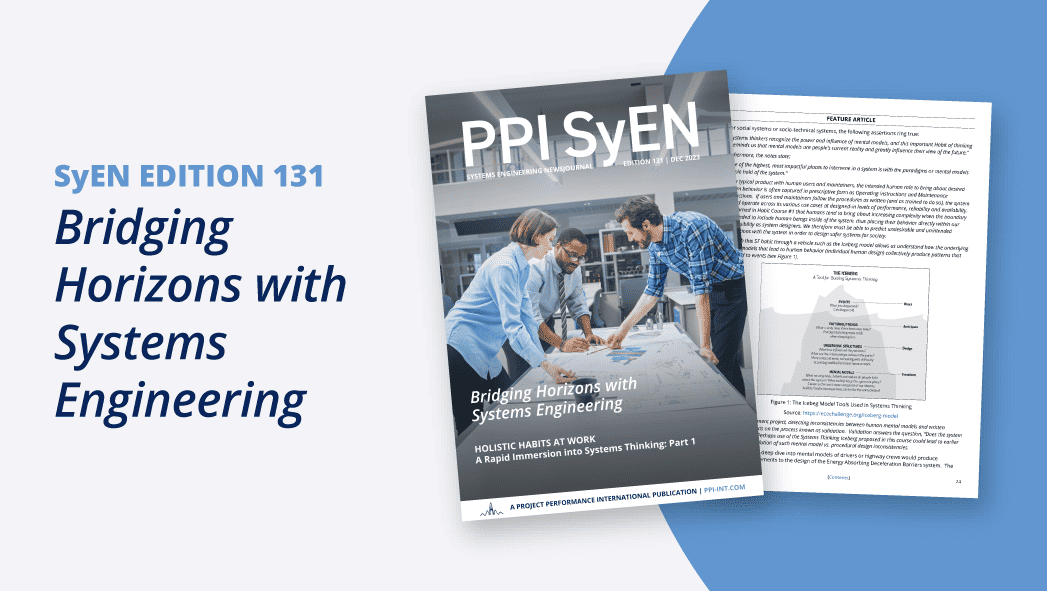IN THIS EDITION
1. Quotations to Open On
2. Feature Articles
2.1 INCOSE Outreach: Forming Relationships and Strategic Alliances
2.2 Three Views of Systems Engineering
3. Additional Articles
3.1 An Essay Concerning the Importance of Cognitive Bias in Systems
4. Systems Engineering News
4.1 Virtual INCOSE IS 2020: Jul 20, 2020 – Jul 22, 2020
4.2 Launch of the PPI-INCOSE Systems Engineering Tools Database (SETDB) Working Group Website
4.3 The Ocean Systems Engineering Journal: Volume 10, Number 1 March 2020
4.4 INCOSE Nominations and Elections
4.5 New Issue of INSIGHT Practitioners Magazine is Available
4.6 Online Tutorial: “Systems Engineering in the Context of a Product Life Cycle”
5. Featured Organizations
5.1 The QFD Institute
5.2 International Council for Quality Function Deployment
5.3 The Center for Learning with Nature
6. News on Software Tools Supporting Systems Engineering
6.1 Vitech Releases GENESYS™ 2020
6.2 OMG Technical Meeting Overview
7. Systems Engineering Publications
7.1 Human Factors in Simple and Complex Systems
7.2 A Framework for Making Better Infrastructure Decisions
7.3 Exploring Engineering: An Introduction to Engineering and Design
7.4 Fundamentals of Aerospace Engineering: Beginner’s Guide
7.5 Strategies for Creative Problem Solving (3rd Ed)
7.6 97 Things Every Engineering Manager Should Know: Collective Wisdom from the
Experts
7.7 The Manager’s Path: A Guide for Tech Leaders Navigating Growth and Change
8. Education and Academia
8.1 Industrial Systems Engineering International: University of Logistics and Transport in Wroclaw, Poland
8.2 Bachelor of Engineering in Data and Systems Engineering: University of Hong Kong
8.3 Find the right Masters of Systems Engineering Program for You
9. Some Systems Engineering-Relevant Websites
10. Standards and Guides
10.1 ISO 16355 Quality Function Deployment
10.2 ISO/IEC/IEEE 21839:2019 Systems and software engineering — System of systems (SoS) considerations in life cycle stages of a system
11. Some Definitions to Close On
11.1 Quality Function Deployment
11.2 Configuration Management
11.3 Duncker Diagrams
12. Conferences and Meetings
12.1 IEEE Technology Engineering Management Society International Virtual Conference (TEMSCON): June 3rd – 6th, 2020
13. PPI and CTI News
14. PPI and CTI Events
15. Upcoming PPI Participation in Professional Conferences
“The problem definition drives the solution; the adequacy of the problem definition drives the validity of the solution.”
“Impatient people are the ones most likely to find ways to go faster. At least they want to move, to do something. They have a goal, and they are not content with the status quo. There is potential there… I am far more concerned about those who don’t care, who are just fine with the way things are. It’s hard to find potential in apathy….”
Richard Zultner, Quality Function Deployment (QFD) Protagonist
“We are not what we know but what we are willing to learn.”
Mary Catherine Bateson
2.1 INCOSE Outreach: Forming Relationships and Strategic Alliances
by
Mitchell Kerman, Ph.D, Alice Squires, Ph.D., Valkand Jhaveri and Joseph Marvin
International Council on Systems Engineering
April, 2020
Web site: https://www.incose.org/
Email: outreach@incose.org
Abstract
The International Council on Systems Engineering (INCOSE) Outreach organization focuses on developing relationships and strategic alliances with sister organizations and industry partners for the benefit of the engineering community and the world at large. This article introduces the INCOSE Outreach organization, describes recent outreach events and activities, and discusses INCOSE Outreach operations. Readers are encouraged to contact the Outreach organization with any questions and to participate in Outreach activities.
Copyright © 2020 by Kerman, Squires, Jhaveri, and Marvin. All rights reserved.
Introduction
The International Council on Systems Engineering (INCOSE) was founded in 1990 as a not-for-profit membership organization with the objective of providing a concentrated focus on systems engineering (SE) as the world’s premier SE professional society. INCOSE develops and disseminates the interdisciplinary principles and practices that enable the realization of successful systems, and it connects SE professionals with educational, networking, and career-advancement opportunities in the interest of developing the global community of systems engineers and systems approaches to problems. INCOSE produces state-of-the-art work products that support and enhance the SE discipline’s visibility and impact in the world.
INCOSE has grown significantly since its formation in 1990 with a membership that represents a broad spectrum – from student to senior practitioner, from technical engineer to program and corporate management, from science and engineering to business development. Members work together to advance their technical knowledge, exchange ideas with colleagues, and collaborate to advance systems engineering. INCOSE currently has over 17,000 members in more than 70 regional and local chapters. There are over 45 active working groups focused on all aspects and domains of systems engineering, and INCOSE has certified over 3,500 individuals as systems engineering professionals through its certified systems engineering professional (SEP) program.
One of the more critical aspects in any professional organization is in focusing on its impact within the professional community and the world. INCOSE manifests this through not only its products, but also its outreach organization which focuses on developing relationships and strategic alliances with sister organizations and industry partners.
Purpose of INCOSE Outreach
The INCOSE Outreach organization develops and directs a comprehensive portfolio to coordinate INCOSE’s outreach across geographic sector and application domain boundaries. This includes the development and execution of an outreach strategy aligned with and enabling INCOSE’s objectives, particularly to achieve membership growth and increase impact beyond INCOSE’s current bases. The Outreach organization identifies and defines overall outreach strategies and initiatives; coordinates with other INCOSE entities on the execution of outreach campaigns; identifies, facilitates, and manages strategic alliances; and establishes and leads the appropriate supporting structure comprised of volunteer members to execute these objectives.
Overall, Outreach is responsible for assisting INCOSE in connecting with the global engineering community where systems thinking and practice is needed or executed differently. The Outreach organization is open and bi-directional, bridging the engineering communities through a mutual appreciation of and advocacy for systems objectives, perspectives, deployable work products, events, and terminology. Figure 1 below is a high-level input/output flow of information facilitated by INCOSE Outreach.
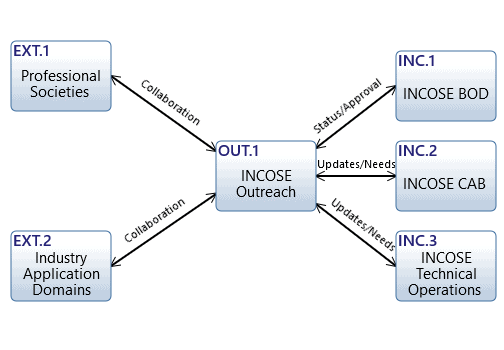
Figure 1: INCOSE Outreach Input/Output Functional Diagram
Figure 1 shows INCOSE Outreach approval and authority coming from the INCOSE Board of Directors (BOD). The INCOSE Corporate Advisory Board (CAB) and Technical Operations receive activity updates from and provide needs to INCOSE Outreach. Established professional societies and industry application domains are key coordination and collaboration focus areas for INCOSE Outreach.
The INCOSE Outreach Organization
The INCOSE Outreach Organization consists of the Director for Outreach and four Assistant Directors for Outreach. The four Assistant Directors are in the areas of Industry and Domain Outreach, Professional Society Outreach, Operations which includes Training and Finance, and Empowering Women Leaders in Systems Engineering (EWLSE) Operations. These Assistant Directors are supported by INCOSE Ambassadors, such as Industry Ambassadors, Domain Ambassadors, and Professional Society Ambassadors. The Ambassadors work in the different areas of the world (or sectors, as defined by INCOSE). Figure 2 shows the INCOSE Outreach Organization chart. Note that the Assistant Director for Outreach Operations position is currently vacant.
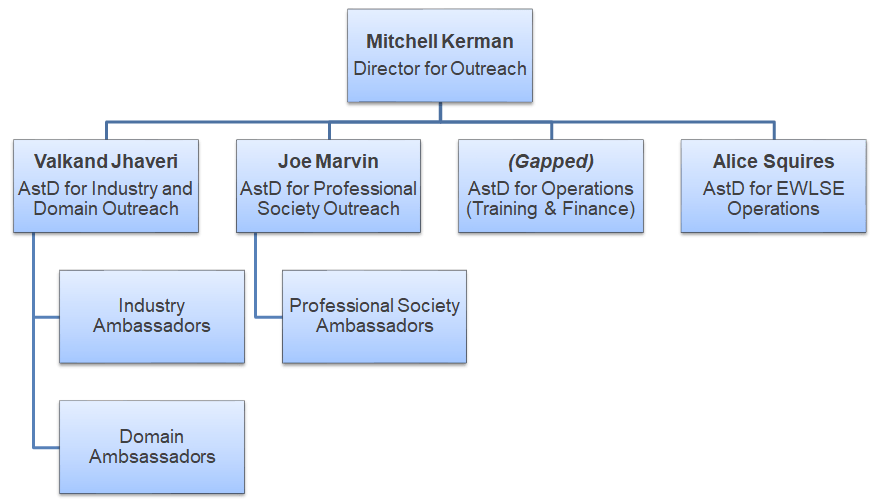
Figure 2: INCOSE Outreach Organization Chart
Recent Outreach Activities
Industry and Domain Outreach Meetings
In December 2019, the Assistant Director for Industry and Domain Outreach, Valkand Jhaveri (VJ), visited Bangkok, Thailand to meet with Mr. Robert Ong, an active INCOSE member. Mr. Ong is a Business Development Director in the Asia Region for Dassault Systems, and the INCOSE Outreach organization is engaging him as an active Industry Ambassador. VJ and Robert discussed the INCOSE organization, reviewing the Chapters, Sectors, and Working Groups. In addition, they reviewed the current INCOSE Ambassador policy and training materials.
VJ also hosted a follow-up meeting with the local Bangkok INCOSE members (Figure 3 on the next page), as their membership is interested in forming a local chapter. While their current membership is too low to form a chapter, VJ discussed ways to recruit membership, including sponsoring information tables at local technical shows and events and making INCOSE promotional materials available to local organizations.
Colorado Aerospace Day
The state of Colorado holds an Aerospace Day event every year, typically on the second Monday of March. The event is held in the state capital of Denver, and attendance includes local Universities and schools, local military representatives (from the Air Force, Navy, Army, National Guard, and US Space Command), aerospace companies (including Boeing, Lockheed Martin, ULA, Raytheon, and SNC), and local manufacturing industries. Local elected officials and their support staff are also in attendance.
As the Assistant Director of INCOSE Industry Outreach and Front Range Colorado Chapter (FRC) Denver Area Director, VJ hosted an INCOSE booth with a small table at this event to advertise INCOSE to the attendees (including the general public) and provide greater information about the discipline of systems engineering. The photograph in Figure 4 shows the VJ at the INCOSE table during this event.
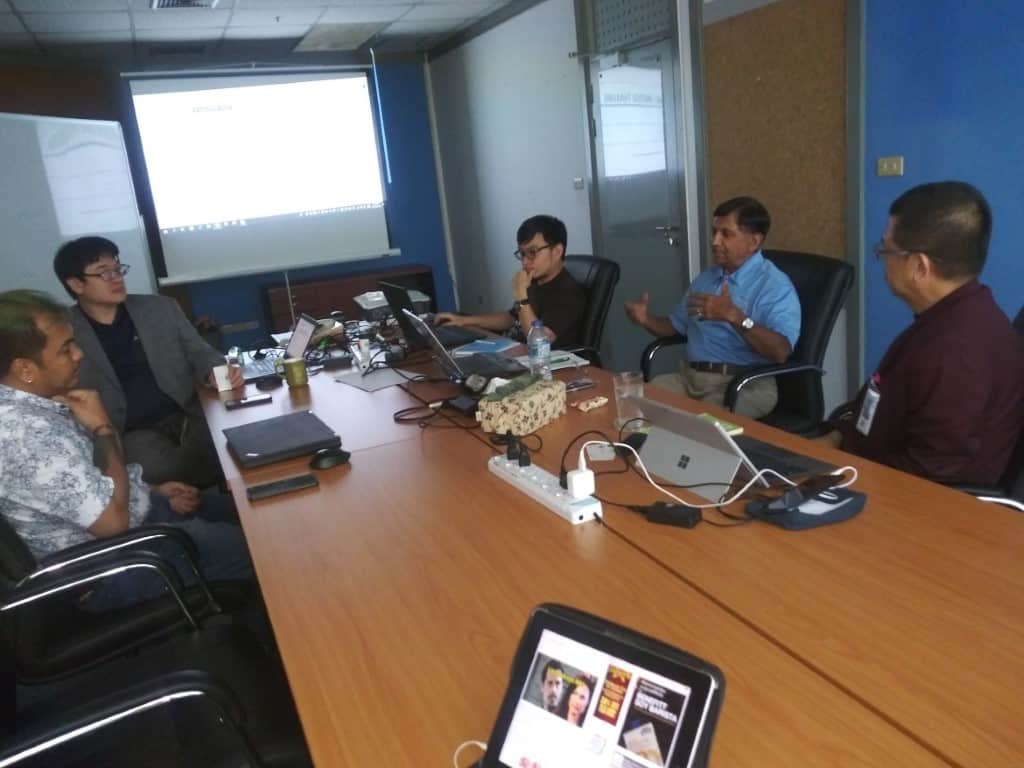
Figure 3: Valkand Jhaveri (in the light blue shirt on the right) meets with local Bangkok INCOSE members in December 2019

Figure 4: Valkand Jhaveri hosts the INCOSE Table at the Colorado Aerospace Day event in March 2020
Embracing Inclusion and Diversity
INCOSE embraces diversity, equity, and inclusion throughout the society at all levels, and is working towards the goal of being one of the lead inclusive and diverse engineering societies in the world. To this end, INCOSE is celebrating the five-year anniversary of the Empowering Women Leaders in Systems Engineering (EWLSE) initiative which has brought the systems engineering community together from around the world to work towards a future where women and men are equally represented as leaders in systems engineering. While the mission is to create an open systems engineering environment welcoming to all, INCOSE understands that this is a work in progress. The INCOSE EWLSE team has made strides in several areas to raise awareness and move towards a more diverse and inclusive INCOSE. In the fall of 2019, INCOSE Insight released the inaugural themed edition “Diversity in Systems Engineering,” which included many varying perspectives of diversity in the community. One article written by INCOSE representatives Alan Harding (an INCOSE Past President) and Andy Pickard (INCOSE Chief of Staff) investigated diversity, with a focus on gender diversity, across INCOSE as the first step to raising awareness of where INCOSE stands on its journey towards an equitable future for all. INCOSE Technical Operations has approved a new “Cross Cutting Category” for ‘Diversity’ as part of the INCOSE International Symposium Call for Papers, Panels, and Tutorials in 2020 and beyond. The public INCOSE EWLSE website (http://incose.org/ewlse) offers a list of resources related to women-centric efforts (see the Resources tab) and both past and current summaries and listings on INCOSE EWLSE sponsored events (see News and Events tab). Two additional publications efforts are underway including a Call for Chapters for a book “Emerging Trends in Systems Engineering Leadership” authored by women with contributing roles for all, and a book of “Letters to My Younger Self: How Systems Engineering Has Changed My Life” targeted to the systems engineers of the future.
INCOSE Outreach Ambassadors
Outreach Ambassadors are INCOSE members who have volunteered to act as industry or external organization focal points. Ambassadors typically represent those industries or are members of those organizations and help to develop relationships, create new relationships and identify joint activities that provide mutual benefit. Outreach Ambassadors form the execution arm of INCOSE Outreach.
Our goal is to build Outreach Ambassador teams for each industry or professional/technical society. These teams build the INCOSE relationship from the beginning of the initiative or agreement to collaborate through development of mature, mutually beneficial relationships which actively and collaboratively identify, coordinate, and conduct activities throughout the INCOSE organization.
Professional Society Outreach has been going on since the formation of INCOSE in 1991. Indeed, the original National Council on Systems Engineering (NCOSE) quickly became the International Council on Systems Engineering as an early recognition that the development of systems engineering knew no boundaries. Along the way, there have been several relationships established between INCOSE and a number of professional societies. Table 1 provides a summary of the currently developing relationships between INCOSE and other professional societies.
Table 1: INCOSE Outreach Agreements
| Professional Society | Relationship | Est. |
| Association for the Advancement of Artificial Intelligence (AAAI) | MOU In Process | |
| American Public Transportation Association (APTA) | MOU Exploration Stage | |
| American Society for Engineering Education (ASEE) | MOU Exploration Stage | 3/5/2020 |
| American Society of Mechanical Engineers (ASME) | MOU In Process | |
| International Society for the Systems Sciences (ISSS) | MOU Exploration Stage | |
| International Wireless Communications Expo | MOU | 10/7/2019 |
International Association for the Engineering Modelling, Analysis and Simulation Community (NAFEMS) |
MOU | 6/19/2019 |
Networking Knowledge of Large Infrastructure Projects in Europe (NETLIPSE) |
MOU Exploration Stage | |
Project Management Institute (PMI) |
MOU In Process | |
Society of Automotive Engineers (SAE) |
MOU | 9/26/2018 |
Water & Sanitation for the Urban Poor (WSUP) |
MOU In Process |
It is clear from the breadth of the relationships that an active body of professional society INCOSE Outreach Ambassadors is needed to develop and advance these relationships. This is the responsibility of professional society Outreach Ambassador teams representing INCOSE. This role includes support to develop and administer the formal agreements between societies, to working group activities, and to the generation of usable materials and products. Our goal is to develop and foster healthy relationships that mutually return exceptional value to the community.
Outreach Operations
The INCOSE Outreach organization works with the INCOSE leadership to establish Memoranda of Understanding (MOUs) and Memoranda of Agreement (MOAs) with organizations in order to develop and nurture impactful strategic relationships. An MOU is a non-binding agreement between two or more parties outlining broad concepts of mutual understanding, goals, and general plans. An MOU is often the first stage in the formation of an MOA, which is a non-binding agreement describing specific terms, conditions, and details, including each party’s requirements, roles, responsibilities, and actions to achieve its goals. An MOA may lead to a formal contract. The strategy behind establishing these relationships and the integration of these documents is critical to their impact on INCOSE. While relationships with several organizations have been quite successful, many have languished. The INCOSE Outreach organization is striving to improve in this regard, and we are actively and continually seeking Ambassadors to act in the capacity of relationship managers to assist us in forming and continuing these strategic alliances.
Outreach Strategy and Path Forward
As previously described, INCOSE conducts Outreach to establish impactful strategic relationships. The INCOSE Vision of “A better world through a systems approach” and Mission Statement to “address complex societal and technical challenges by enabling, promoting, and advancing systems engineering and systems approaches” require global outreach as an imperative. Figure 5 shows that INCOSE Outreach is the organization which “glues together” the INCOSE Strategic Objectives.
INCOSE recognizes that it cannot achieve these objectives working in isolation. Strategic discussions and agreements with industry partners, academia, and sister professional societies are paramount to our strategy.
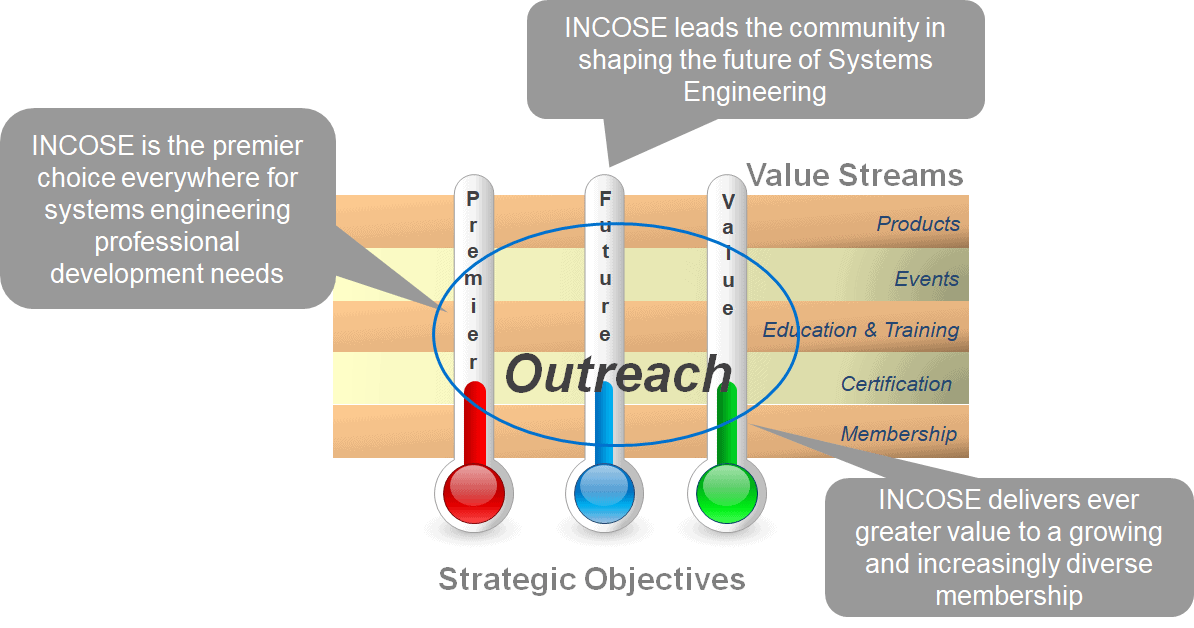
Figure 5: INCOSE Outreach forms the “glue” that links together the INCOSE Strategic Objectives
At the INCOSE International Workshop held in Torrance, CA in January of 2020, the INCOSE Outreach organization and Director for Strategic Integration held a strategy session. This strategy session was designed to explore which organizations INCOSE should target establishing agreements and the criteria used in determining these organizations, the charter of an INCOSE Outreach Ambassador and Relationship Manager, the appointment and training of INCOSE Ambassadors, and the mechanisms by which to maintain the awareness and status of strategic alliances. The execution of the recommendations developed by the strategy session participants is still underway, and INCOSE Outreach is continually making progress in establishing better procedures and processes.
Contact Information
If you would like to volunteer or become involved with the INCOSE Outreach organization, we would be grateful for your assistance and participation. Please contact outreach@incose.org or mitchell.kerman@inl.gov for more information.
List of Acronyms Used in this Paper
Acronym Explanation
BOD Board of Directors
CAB Corporate Advisory Board
INCOSE International Council on Systems Engineering
NCOSE National Council on Systems Engineering (predecessor to INCOSE)
EWLSE Empowering Women Leaders in Systems Engineering
MOU Memorandum of Understanding
MOA Memorandum of Agreement
TechOps Technical Operations
References
“About INCOSE.” Accessed March 1, 2020. https://www.incose.org/about-incose.
“PDD – 012: Director for Outreach.” INCOSE, February 5, 2020. https://www.incose.org/docs/default-source/elections/pd-029-director-for-outreach.pdf?sfvrsn=593bb4c6_4
“OUT-100: Outreach Principles.” INCOSE, January 24, 2018. https://www.incose.org/docs/default-source/policiesbylaws/out-100-outreach-principles.pdf?sfvrsn=e24e82c6_10
“OUT-101: Guidelines for the Formation and Approval of Alliances, MOUs, and MOAs.” INCOSE, July 25, 2019. https://www.incose.org/docs/default-source/policiesbylaws/out-101-guidelines-for-alliances-mous-and-moas.pdf?sfvrsn=33219fc6_4.
“OUT-103: Ambassadors – 26 April 2019.” INCOSE, April 26, 2019. https://www.incose.org/docs/default-source/policiesbylaws/out-202.pdf?sfvrsn=c7aa85c6_16
About the Authors
 Dr. Mitchell Kerman is the INCOSE Director for Outreach. He is the Chief of Staff and Chief Systems Engineer to the Energy and Environment Science & Technology (EES&T) Associate Laboratory Director at Idaho National Laboratory (INL). In addition to being responsible for program execution and performance on all programs under the EES&T Directorate, he manages over 250 scientists and engineers, including talent recruitment, retainment, training, mentoring, professional development, career growth, and recognition. Dr. Kerman has a diverse background with extensive experience in computer modeling and simulation, operations research, systems engineering, engineering management, and business development. Prior to joining INL, he was the Director of Program Development and Transition for the Systems Engineering Research Center (SERC), a Department of Defense University Affiliated Research Center (UARC) led by Stevens Institute of Technology in Hoboken, New Jersey. Dr. Kerman has taught graduate classes in both operations research and systems engineering. He is the author of two textbooks on the topics of computation and introductory computer programming and has published numerous articles in technical journals and trade publications. Dr. Kerman is also a retired Navy officer with 27 years of combined active duty and reserve experience in submarine warfare, naval coastal warfare, coordination and guidance of merchant shipping, and NATO operations. Dr. Kerman has a Bachelor of Science in computer systems engineering from Arizona State University, a Master’s of Science in operations analysis from Naval Postgraduate School, and a PhD in systems engineering from Stevens Institute of Technology.
Dr. Mitchell Kerman is the INCOSE Director for Outreach. He is the Chief of Staff and Chief Systems Engineer to the Energy and Environment Science & Technology (EES&T) Associate Laboratory Director at Idaho National Laboratory (INL). In addition to being responsible for program execution and performance on all programs under the EES&T Directorate, he manages over 250 scientists and engineers, including talent recruitment, retainment, training, mentoring, professional development, career growth, and recognition. Dr. Kerman has a diverse background with extensive experience in computer modeling and simulation, operations research, systems engineering, engineering management, and business development. Prior to joining INL, he was the Director of Program Development and Transition for the Systems Engineering Research Center (SERC), a Department of Defense University Affiliated Research Center (UARC) led by Stevens Institute of Technology in Hoboken, New Jersey. Dr. Kerman has taught graduate classes in both operations research and systems engineering. He is the author of two textbooks on the topics of computation and introductory computer programming and has published numerous articles in technical journals and trade publications. Dr. Kerman is also a retired Navy officer with 27 years of combined active duty and reserve experience in submarine warfare, naval coastal warfare, coordination and guidance of merchant shipping, and NATO operations. Dr. Kerman has a Bachelor of Science in computer systems engineering from Arizona State University, a Master’s of Science in operations analysis from Naval Postgraduate School, and a PhD in systems engineering from Stevens Institute of Technology.
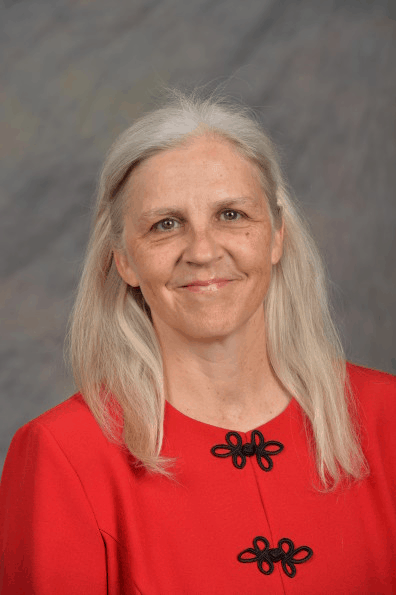 Dr. Alice Squires is the INCOSE Assistant Director for Outreach in EWLSE Operations. She has over thirty years of technical and leadership experience. Prior to joining Washington State University in the Fall 2014 as a full-time faculty, Alice served as Manager of Systems Engineering at Aurora Flight Sciences, Senior Researcher for the nationwide University Affiliated Research Center in Systems Engineering, Online Technical Director for the School of Systems and Enterprises (SSE) at Stevens Institute of Technology, Senior Systems Engineer consultant to Lockheed Martin, IBM, and EDO Ceramics, Senior Engineering Manager at GD, Senior Engineering Manager at LM, and Advisory Engineer/Scientist at IBM. Alice continues to be a contributing author and editor to the Systems Engineering Body of Knowledge (sebokwiki.org) and the Graduate Reference Curriculum for Systems Engineering (bkcase.org/grcse). She is certified by PMI as a Project Management Professional, and by INCOSE as an Expert Systems Engineering Practitioner, including in Acquisition. Alice is a lifetime member of the Beta Gamma Sigma, Tau Beta Pi, and Eta Kappa Nu Honor Societies. She is a Senior Member of the IEEE, a member of and Director on the Systems Engineering Division board of the American Society of Safety Engineers (ASEE), and a member of the National Defense Industrial Association (NDIA), INCOSE, and the Project Management Institute (PMI).
Dr. Alice Squires is the INCOSE Assistant Director for Outreach in EWLSE Operations. She has over thirty years of technical and leadership experience. Prior to joining Washington State University in the Fall 2014 as a full-time faculty, Alice served as Manager of Systems Engineering at Aurora Flight Sciences, Senior Researcher for the nationwide University Affiliated Research Center in Systems Engineering, Online Technical Director for the School of Systems and Enterprises (SSE) at Stevens Institute of Technology, Senior Systems Engineer consultant to Lockheed Martin, IBM, and EDO Ceramics, Senior Engineering Manager at GD, Senior Engineering Manager at LM, and Advisory Engineer/Scientist at IBM. Alice continues to be a contributing author and editor to the Systems Engineering Body of Knowledge (sebokwiki.org) and the Graduate Reference Curriculum for Systems Engineering (bkcase.org/grcse). She is certified by PMI as a Project Management Professional, and by INCOSE as an Expert Systems Engineering Practitioner, including in Acquisition. Alice is a lifetime member of the Beta Gamma Sigma, Tau Beta Pi, and Eta Kappa Nu Honor Societies. She is a Senior Member of the IEEE, a member of and Director on the Systems Engineering Division board of the American Society of Safety Engineers (ASEE), and a member of the National Defense Industrial Association (NDIA), INCOSE, and the Project Management Institute (PMI).
 Valkand Jhaveri retired from ULA/Lockheed Martin in 2015, and currently serves as both the Denver Area Director for FRC INCOSE and the INCOSE Assistant Director for Industry Outreach. VJ has been an active member and leader in INCOSE for over 20 years. He is best known for actively mentoring young college and STEM schools students. VJ has over 30 years of experience in Engineering Management and Leadership with specific expertise in requirements, documents, systems engineering, planning, process, design, integration and testing. He is a highly motivated and energetic problem solver with functionally diverse experience in the aerospace and IT industries. His experience and overall knowledge span years of experience in 1) Design engineering, drawing configuration control, requirements, specifications and standards; 2) IT sales, project consultation with automotive, pharmaceutical, aerospace, consumer products, and transport/construction equipment; 3) Systems engineering principles, requirements databases and military/industry standards; 4) Satellites, Launch Vehicles (Titan, Atlas, Delta, Vulcan, Athena) upper stages requirements, design, analyses, trade studies, specifications, tests, launch complex and facilities, and equipment; 5) Mechanical, hydraulic ground equipment design, test, and consumer support; and 6) Management and supervision. VJ holds a Master’s of Science in Systems/Mechanical Engineering from Marquette University in Milwaukee, WI.
Valkand Jhaveri retired from ULA/Lockheed Martin in 2015, and currently serves as both the Denver Area Director for FRC INCOSE and the INCOSE Assistant Director for Industry Outreach. VJ has been an active member and leader in INCOSE for over 20 years. He is best known for actively mentoring young college and STEM schools students. VJ has over 30 years of experience in Engineering Management and Leadership with specific expertise in requirements, documents, systems engineering, planning, process, design, integration and testing. He is a highly motivated and energetic problem solver with functionally diverse experience in the aerospace and IT industries. His experience and overall knowledge span years of experience in 1) Design engineering, drawing configuration control, requirements, specifications and standards; 2) IT sales, project consultation with automotive, pharmaceutical, aerospace, consumer products, and transport/construction equipment; 3) Systems engineering principles, requirements databases and military/industry standards; 4) Satellites, Launch Vehicles (Titan, Atlas, Delta, Vulcan, Athena) upper stages requirements, design, analyses, trade studies, specifications, tests, launch complex and facilities, and equipment; 5) Mechanical, hydraulic ground equipment design, test, and consumer support; and 6) Management and supervision. VJ holds a Master’s of Science in Systems/Mechanical Engineering from Marquette University in Milwaukee, WI.
 Joseph (Joe) Marvin is the INCOSE Assistant Director for Professional Society Outreach. He has served in a number of INCOSE roles across the organization since 2007 as a member of the Central Arizona Chapter. These roles include: Chapter President, Chair of the Small Business Systems Engineering Working Group (formerly VSEWG), Tech Ops Assistant Director for Industry, Tech Ops Assistant Director for Internal Operations, Assistant to Director for Outreach and Future of Systems Engineering (FuSE) Artificial Intelligence subcommittee. Joe is a systems engineer who started his career with the United States Air Force as a Space System Research and Development Engineer. After military service he held Chief Systems Engineering and Program Manager industry roles with Lockheed Martin and SAIC on major system acquisitions in defense. He currently serves as President of Prime Solutions Group, Incorporated (PSG), a systems and software development business he founded in 2007. Joe championed PSG’s membership in the INCOSE Corporate Advisory Board and acts as the PSG CAB Representative. Joe was awarded ESEP certification in 2011 and has actively participated in both International Symposiums and International Workshops continuously since 2009.
Joseph (Joe) Marvin is the INCOSE Assistant Director for Professional Society Outreach. He has served in a number of INCOSE roles across the organization since 2007 as a member of the Central Arizona Chapter. These roles include: Chapter President, Chair of the Small Business Systems Engineering Working Group (formerly VSEWG), Tech Ops Assistant Director for Industry, Tech Ops Assistant Director for Internal Operations, Assistant to Director for Outreach and Future of Systems Engineering (FuSE) Artificial Intelligence subcommittee. Joe is a systems engineer who started his career with the United States Air Force as a Space System Research and Development Engineer. After military service he held Chief Systems Engineering and Program Manager industry roles with Lockheed Martin and SAIC on major system acquisitions in defense. He currently serves as President of Prime Solutions Group, Incorporated (PSG), a systems and software development business he founded in 2007. Joe championed PSG’s membership in the INCOSE Corporate Advisory Board and acts as the PSG CAB Representative. Joe was awarded ESEP certification in 2011 and has actively participated in both International Symposiums and International Workshops continuously since 2009.
2.2 Three Views of Systems Engineering
This article is a collection of thoughts based on conversations and readings. The main idea is that systems engineering (SE) is viewed from three perspectives among seasoned practitioners. The central focus is that SE is not “another branch of engineering”, but rather SE provides generic principles applicable to all engineering disciplines, and even outside of engineering. The three perspectives are as follows: First, it is a branch of systems science. Next, it is another name for design management. Finally, it is a meta-discipline that links all the design specialties together.
View Number 1: SE is a branch of systems science.
The support for this view comes from the BKCASE Editorial Board 2016, Part 2: Foundations of Systems Engineering. Figure 1 illustrates the approximate relationship among the various systems disciplines. This chart should not be viewed as authoritative, but it is close enough for analysis and discussion. As seen in this chart, systems science is the over-arching discipline. Systems science brings to the table such concepts as holism (any situation is part of a bigger picture and the system needs to be considered as a whole), emergence (the whole is more than the sum of its parts), and hierarchy (having different levels with one level forming the context for the next). In short, emergent properties only appear when the system of sub-systems is viewed as a whole. In the same sense that this is true for components, it is also true for disciplines. A basic assumption is that all these concepts pertain to the derivative disciplines as well. One of those derivative disciplines is Systems Engineering (SE), i.e. the discipline covering engineered systems, including social, health, environmental, or even political systems. Hence, SE is a branch of systems science pertaining specifically to traditional engineering, or so it is perceived. It is natural to assume that the general discipline (systems science) will be at the top and that the practical implementation (SE) will be at the bottom.
Figure 1: Systems Science Hierarchy
It is important to point out that in an SE context, the term “engineering” does not necessarily mean engineering in a traditional sense. In a recent poll conducted by the INCOSE Fellows (Arnold and Jackson 2018), most experienced systems engineers consider SE to cover traditional engineering and more. In an informal way, in an SE context “engineering” can mean to put something together intelligently for a specific purpose.
So why is it important or at least useful to know that SE is a branch of systems science? The simple answer is that all the concepts relevant in systems science such as inter alia systems approach, systems thinking, and systems architecting are also relevant at the more practical, or SE, level and are therefore important in the design of real systems.
View Number 2: SE is another name for design management. Alexander Kossiakoff and William N. Sweet, in their classic book Systems Engineering: Principles and Practice (Kossiakoff and Sweet, 2003), view SE as a branch of project management. The book describes every aspect of project management that leads to the design, production, operation, and support of a system. These aspects include system development, needs analysis, concept exploration, concept definition, engineering design, and integration and evaluation. Although SE does include aspects of project management, the focus is subtly, yet essentially different. This overlap is confirmed by the Systems Engineering Body of Knowledge (SEBOK) where project management and systems engineering often share methodologies that can vary in size depending on the project. However, SE is about considering the holistic problem from initiation through development, production, and operation to decommissioning and discarding. It requires strong management skills and prior experience, but more importantly, it also requires strong technical depth. SE focuses on the product domain and the managerial processes to support that product, while PM focuses on managerial issues in the project domain. This is also confirmed in the article by Sharon et.al. (Sharon, 2011). However, they also confirm them to be tightly intertwined, requiring a high level of communication to ensure project success.
So why is it important to view SE as another name for design management, or then even Design Management as another name for SE. The first indication is the similarities in the definition of the two fields. Kettering University confirms the definition of SE to be the “primary interface between management, customers, suppliers, and specialty engineers in the systems development process”. The Design Management Institute (DMI) (DMI 2020) defines DM: “design management seeks to link design, innovation, technology, management, and customers to provide competitive advantage across the triple bottom line” by “using design processes to solve general business problems”. This essentially suggests a similar focus except for SE specifically indicating the systems development process. Both require a sound understanding of the business strategy as well as customer needs and technical depth to find the relevant solution.
Traditional SEs will argue that SE has been doing design management all along while DM is coming through as a discipline on its own driven by the architecture and the Fast Moving Commercial Goods (FMCG) industries. So what then is the essential difference? The main difference is that SE is defined as the realization of complex systems whereas DM is aimed at design in general. This suggests a level difference in system complexity between SE and DM. However, looking deeper into DM, it uses processes similar to, but tailored from, the traditional SE processes to convert customer requirements to products. This suggests the two approaches to be similar. So why create a new discipline to do the same as an existing discipline?
The answer may lie in the resistance often encountered in the more commercial environments not generally known for implementing systems engineering. The reasons for this are multiple as indicated by Russel Ackoff [Ackoff] as well as Oliver Hoehne [Hoehne]. They include inter alia outcomes being perceived as delayed, since they do not result in the quick fixes expected due to ignorance or misunderstanding of the process, perceived loss of control, no direct benefit to the project manager, and resistance due to fear of failure (the unknown vs the limited success of the known due to not being competent in the process).
The recent past has proven that an increase in technological capability and features results in more complex system. Complex systems generally come with multiple complex subsystems bringing with them complex interfaces (especially when safety is important) and elaborative documentation. This generally is then perceived as too cumbersome for the high paced commercial environment of FMCG or the seemingly less complex environment of architecture and subsequently resulted in a resistance to traditional SE. Russel Ackoff attributes this to organizational decision makers generally not having experience or even exposure to systems thinking and the true value of it. However, due to their success, SE processes are selectively applied in DM to ensure project success and a faster turnaround. It generally uses simplified SE processes and documentation tailored to the specific environment without referring to it as systems engineering. This should not be confused with agile SE. As indicated by Yaneer Bar-Yam [Bar-Yam] the problem is not in the simplification, but in making the wrong choice while simplifying. Systems thinking is often perceived to be a short-cut to good SE. Making the right choice, however, does not come from systems thinking only, but from experience and thorough understanding of the SE process. It is this experience that allows for effective simplification.
An important consideration from the above is that SE was coined during the 60s to improve the safety and reliability of the defense aircraft industry; hence the hugely complex, and often cumbersome set of documentation and the subsequent resistance from the commercial industry. However, with the development of technology and the fourth industrial revolution almost all consumer items as well as architectural designs today can be considered to be systems with multiple features consisting of multiple subsystems with their different interface requirements. With often no safety requirements, they are deemed not to require SE due to the perceived risk of getting it wrong and the short lead times required. It nevertheless remains a system requiring a holistic view, i.e. systems thinking, especially due to the tight schedules and budgets, to ensure the desired outcome in the shortest possible time. Increasing pressure on sustainability forces consideration of all phases from customer need identification to repair/replace and discarding strategy. In essence, DM uses SE processes in a tailored format to simplify the process and therefore can be seen as a subset of SE or SE to be another, more encompassing name for DM.
There is motivation to consider DM as a possible alternative name for traditional SE, even though it could be seen as less encompassing than SE. The reasoning behind this is two-fold. There is an increasing use of SE principles in industry, and even outside engineering, in order to reduce turnaround time while still ensuring product quality. This creates a need for a streamlined SE approach to support commercial strategies and time lines, and a name that is more descriptive of the commercial SE process. The term “SE” has been hijacked by the IT industry to be related to software or computer related processes. Although there are many similarities between software SE and traditional SE processes, they are different. Due to the communication advantage of the IT industry, SE has become a term highly associated with the IT industry. This becomes especially evident when searching for SE jobs based on the high percentage of SE-jobs postings being related to IT positions. In order to regain some traction in the importance and value of traditional SE in the commercial environment, it could make sense to consider another descriptive name. Sharing a similar definition, DM offers an option to expand the current DM focus to also include the hardcore/heavy engineering industries, but tailoring it to accommodate the commercial nature of businesses in general. This can then include simulation models for more complex designs in order to support effective decision making about the road forward. It can therefore be reasoned that DM offers a suitable alternative name to the traditional SE, but it would then need some expansion to include a generic, yet more commercially focused methodology to traditional SE.
View Number 3: SE is a meta-discipline that links all the design specialties together. INCOSE Pioneer Peter Checkland planted the seed for this view with the following comment (Checkland 1999):
. . . [systems] is different in kind from other disciplines. Its concern is not a particular set of phenomena, as in the case with chemistry and physics, for example; neither is it like biochemistry, a subject which has arisen at the overlapping of existing subjects. Nor is it a subject which exists because a particular problem area is important and requires the bringing together of a number of different streams of knowledge—as do town planning or social administration, for example. What distinguishes systems is that it is a subject which can talk about the other subjects. It is a meta-discipline whose subject matter can be applied within virtually any other discipline.
Of course, Checkland was talking about systems in general. But by extension, his comments would also apply, in particular, to SE.
So why is it important that SE can be regarded as a meta-discipline? It is because real systems, whether they be physical or abstract, need to be put together (engineered) in a logical way. This requires the abilities to zoom out and contextualize a problem in the bigger picture and then in a systematic and logical process, resolve the issues to find the most suitable solution. SE at its core provides this methodology outside the objects that allow the system to become an “engineered” system. SE therefore is a way of thinking which through prolonged exposure develops the skills of considering all contributing disciplines necessary to effectively resolve the issue at hand. The implementer does not need to be an expert in all the relevant fields, but needs to investigate and understand the role the discipline plays in arriving at the solution in order to define and manage the interfaces. It is this ability to dissect the problem that becomes a generic skill that, as according to Checkland, can be applied to virtually any discipline. This is the fundamental basis supporting the view that SE in essence is a meta-discipline.
Conclusion
Based on the above the reader might now be asking the question, “Which view is right?” The simple answer is, all three. After all, from View Number 1 if you are “engineering” a system, you would want to be sure that the resulting system complies with the principles of systems science and effectively uses the features of the various subsystems to yield the unique features of the system. Secondly, from View Number 2, you would want to assure that the different functions in an organization and the various design processes are integrated effectively to create a system supporting the business objective as well as customer requirements. Finally, from View Number 3, you would want to ensure that all the disciplines (stakeholders) were considered and integrated to create the most suitable system satisfying the pre-defined requirements, i.e. a system of high quality.
Since this article is an informal collection of ideas, comments are strongly encouraged.
Ackoff, R, “Why few organizations adopt systems thinking”, accessed 4 April 2020, https://thesystemsthinker.com/why-few-organizations-adopt-systems-thinking/
Arnold, Eileen, and Scott Jackson. 2018. “Analysis of the Systems Engineering World View Survey.” IS 2018, Washington, DC, July.
Bar-Yam, Yaneer, 2003, “When systems engineering fails-toward complex systems engineering,” SMC’03 Conference Proceedings. 2003 IEEE International Conference on Systems, Man and Cybernetics. Conference Theme – System Security and Assurance (Cat. No.03CH37483), Washington, DC, pp. 2021-2028 vol.2.
BKCASE Editorial Board, 2016, “Systems Engineering Body of Knowledge (SEBoK).” http://sebokwiki.org/wiki/Guide_to_the_Systems_Engineering_Body_of_Knowledge_(SEBoK).
Checkland, Peter. 1999. Systems Thinking, Systems Practice. New York: John Wiley & Sons.
DMI, 2020, “Definition of Design Management.” accessed 31 March. https://www.dmi.org/page/What_is_Design_Manag.
Hoehne, OM, 2014, “On motivating people to implement systems enigneering”, INCOSE International Symposium, Las Vegas, NV, June 30 – July 3, Volume 24, Issue 1, Pages 362 – 377.
Kossiakoff, Alexander, and William N Sweet. 2003. Systems Engineering: Principles and Practice. Edited by Andrew Sage, Wiley Series in Systems Engineering and Management. Hoboken, NJ: John Wiley & Sons.
Amira Sharon, Olivier L. de Weck, and Dov Dori, Project management vs. systems engineering management: A practitioners’ view on integrating the project and product domains. 27 April 2011, https://doi.org/10.1002/sys.20187.
3.1 Three Views of Systems
by
Scott Jackson
Principal Systems Engineer and INCOSE Fellow
Editor’s note: Scott Jackson and Avi Harel provided an article entitled “Systems Engineering Decision Analysis can benefit from Added Consideration of Cognitive Sciences” that was published in the July 2017 issue of PPI SyEN.
History is replete with examples of scientists whose revolutionary discoveries never saw the light of day due to various obstacles. Such a scientist was the geneticist Nikolai Vavilov, whose discoveries into the breeding of grains promised to save the lives of millions of Russians during World War II. His main obstacles were Soviet leader Josef Stalin and other geneticists who opposed his work. We know today that his work was sound.
The Question of Importance
This suggests the question of importance. How can we measure the importance of a decision? The number of lives saved is one way. However, we don’t want to go down that path because there are other ways to measure importance. We want to stay focused on the question at hand: can humans make rational decisions? And if not, what can be done about it?
The Study of Flawed Decisions
I first became aware of this question when reading the book The Undoing Project by Michael Lewis (Lewis 2016). This book chronicles the friendship and work of Daniel Kahneman and Amos Tversky, both psychologists. They discovered that the human brain “is not wired for rational thought.” This got my attention, but not that of many others, at least people with the influence to make important changes. Another researcher that contributed to the field of flawed decisions was Richard Thaler who invented ways to “nudge” people to make better decisions. Kahneman and Thaler both received the Nobel Prize for their work. However, Tversky passed away before the prize was awarded. Hence, he was not eligible to receive it. In this essay, I document several reasons concerning why this discovery has gotten so little attention and so little action.
A Comparison of Technical and Psychological Findings on Decisions
The first reason, not necessarily the most important one, is that I am not a scientist; my credentials are in engineering, specifically, in systems engineering. For those not familiar with this term, it has little to do with computers. Also, it is not a branch of traditional engineering, such as mechanical or electrical engineering. It has been described as a meta-discipline that cuts across all branches of engineering and other areas too, such as psychology and behavioral economics. Systems engineering includes the study of decision management, described in the literature such as the INCOSE Systems Engineering Handbook, pp. 110-114. It is in the systems engineering study of decision management where the conflict occurs between the systems engineering view of decision management and the findings of psychology and behavioral economics of Kahneman, Tversky, and Thaler. In short, traditional decision management makes the assumption that humans can make rational decisions. This assumption is totally contrary to the findings of Kahneman, Tversky, and Thaler.
Cognitive Bias
Next, we need to discuss the concept of cognitive bias. Kahneman, Tversky, and Thaler all mention this concept; it is the root cause of most flawed decisions. According to Haselton, Nettle, and Andrews, 2005, cognitive bias is “a systematic pattern of deviation from the norm or rationality in judgment.” Cognitive bias occurs when decisions are dominated by prior belief or by emotion. Kahneman, 2011, and Thaler and Sunstein, 2008, have identified a large number of individual biases, the most well-known of which is the confirmation bias. This bias states that humans have a tendency to interpret new evidence as confirmation of one’s existing beliefs or theories.
Cognitive Bias in the Systems Engineering Literature
Not surprisingly, there is not much literature on cognitive bias in the systems engineering literature. I have published three articles in INCOSE publications: (1) Jackson and Harel, 2017; (2) Jackson, 2018; and (3) Jackson, 2017. The purpose of these articles was to introduce systems engineers to the concept of cognitive bias; to explain the importance of the concept; and to suggest how this understanding may influence the decision process in a systems engineering context.
Consequences
Another factor in the discussion of decision management and its importance is the discussion of consequences. Most of the early literature on cognitive bias deals primarily with consequences that have little impact on the decision-maker, such as the decision to buy insurance or not. Nevertheless, the impact of cognitive bias seems to be clear for the experiments conducted by the investigators. So, the question still remains: are the conclusions about the effect of cognitive bias still valid for major decisions, such as Columbia, Challenger, and the collision of two 747s? These accidents are cited by several researchers. One group of researchers led by Murata (Murata, Nakamura, and Karwowski 2015) and (Murata 2017) has focused on disasters such as these.
Obstacles
From the above investigations, it is clear that the cognitive bias phenomenon is valid and applies to both low- and high-consequence cases. So why are they so little discussed in the systems engineering literature? The following discussion is somewhat speculative; however, much of it is based on personal experiences.
The Silo Effect. This is a well-known effect in industry. I have observed it, and you may have as well. It simply means that many people want to work within their own specialty and do not want to work with other people or other specialists. The study of decisions with cognitive bias requires engineers to work with psychologists. This requirement puts a strain on the cooperation between disciplines, to say the least.
In addition, as described by (Sillitto et al. 2018), it must be recognized that a feature of modern systems engineering is transdisciplinarity. This means that systems engineering should be accomplished across disciplines. A good source for understanding transdisciplinarity is (Madni 2018).
The Language Effect. It seems that cognitive bias is not a term that is familiar to most engineers.
The Over-Confidence Effect. This is a phenomenon that I have witnessed many times. There is a common belief that intelligent humans can always make the right decisions in spite of the cognitive biases that may exist. Their belief is that once they have been exposed to a common bias, such as the confirmation bias, then the problem is solved and they will never be a victim to this bias. This belief presupposes that they have already studied hundreds of recognized biases and are prepared to make the right decisions. Setting the irrationality of this belief aside, it also flies in the face of the findings of Kahneman, Tversky, and Thaler who have concluded that all humans are subject to these biases.
Mitigation
Mitigation methods will depend on (1) specific bias, (2) whether mitigation is external or internal. Biases involving a large number of people are external, that is, external to the decision-maker. Biases depending on organizational structure are external. Self-mitigation is only possible if the risk is low.
Independent authority is an important external method recommended by the Columbia Accident Investigation Report (NASA 2003) and would entail decisions by an organization external to the program in question.
The literature cites a number of group methods including the pre-mortem favored by Kahneman. In this method, the decision maker would rely on a number of trusted members of the organization to present worst-case scenarios.
Summary
The primary purposes of this essay are (1) to explore how issues of importance can gain maximum visibility and acceptance, and (2) to show that the phenomenon of cognitive bias is very important, due to the catastrophes that have occurred as a result of the lack of understanding of it.
I do not claim to have made any significant scientific discoveries with respect to cognitive bias. Rather, I am an observer of significant work by Kahneman, Tversky, Thaler, Murata, and others.
Our challenge is to bring these discoveries to light and implement them in system enterprises.
References
Haselton, Martie G., Daniel Nettle, and Paul W. Andrews. 2005. “The Evolution of Cognitive Bias.” In Handbook of Psychology.
INCOSE. 2015. Systems Engineering Handbook. edited by SE Handbook WG. Seattle, CA: International Council on Systems Engineering.
Jackson, Scott. 2017. “Irrationality in Decision Making: A Systems Engineering Perspective.” Insight, 74.
Jackson, Scott. 2018. “Cognitive Bias: A Game-Changer for Decision Management?” Insight, 41-42.
Jackson, Scott, and Avi Harel. 2017. “Systems Engineering Decision Analysis can benefit from Added Consideration of Cognitive Sciences ” SyEN 55, 19 July.
Kahneman, Daniel. 2011. Thinking Fast and Slow. New York: Farrar, Straus, and Giroux.
Lewis, Michael. 2016. The Undoing Project: A Friendship that Changed our MInds: W. W. Norton.
Madni, Azad M. 2018. Transdisciplinary Systems Engineering; Exploiting Convergence in a Hyper-Connected World. New York: Springer.
Murata, Atsuo. 2017. “Cultural Difference and Cognitive Biases as a Trigger of Critical Crashes or Disasters – Evidence from Case Studies of Human Factors Analysis.” Journal of Behavioral and Brain Science 7:299-415.
Murata, Atsuo, Tomoko Nakamura, and Waldemar Karwowski. 2015. “Influences of Cognitive Biasas in Distorting Decision Making and Leading to Critical Unfavorable Incidents.” Safety 1:44-58.
NASA. 2003. Columbia Accident Investigation Report. edited by Robert Godwin. Washington, DC: National Aeronautics and Space Administration (NASA).
Sillitto, Hillary G., James Martin, Regina Griego, Dorothy McKinney, Dov Dori, Scott
Jackson, Eileen Arnold, Patrick Godfrey, and Daniel Krob. 2018. “A fresh look at Systems Engineering – what is it, how should it work?” IS 2018, Washington, DC.
Thaler, Richard H., and Cass R. Sunstein. 2008. Nudge: Improving Decisions About Health, Wealth, and Happiness. New York: Penguin Books.
4.1 Virtual INCOSE IS 2020
Jul 20, 2020 – Jul 22, 2020
The INCOSE IS 2020 virtual event will be held on 20-22 July 2020. It will now be a three (3) day event offering three (3) parallel tracks. Outlined below are some of the benefits you will receive when you register to participate in our virtual INCOSE IS 2020 event.
You will be able to:
- Participate in real time in any of the sessions.
- Access recorded sessions should the time of the session not be suitable for you.
- Interact with the presenters through chat rooms and follow-up discussions.
- Hear firsthand the keynote speakers. INCOSE will schedule these sessions at a time where we have the greatest opportunity to support the majority of participants to “watch live.”
- Witness the honors and awards bestowed on fellow members, colleagues, and champions of systems engineering.
- Network across virtual social functions.
- Interact with exhibitors and sponsors through virtual exhibit halls and chat rooms.
- Receive a copy of the proceedings.
To address some operational aspects –
- The registration fee for INCOSE IS 2020, the virtual event, will be discounted from the original fee.
- Registration will open in May.
- The program schedule will be based on South Africa’s time zone, where we originally intended to host the INCOSE IS 2020.
- In the coming days, we will contact everyone with an accepted paper, panel, presentation or tutorial to manage the specifics. We plan to publish all accepted papers for INCOSE IS 2020, even if they are not delivered virtually, unless the author indicates otherwise.
- Exhibitors and sponsors will be contacted directly to work the details.
Further information will be made available over the coming weeks on the INCOSE IS 2020 website, via social media, and other communication means. If you have any general questions relating to this message, please contact us at symposium@incose.org.
4.2 Launch of the PPI-INCOSE Systems Engineering Tools Database (SETDB) Working Group Website
INCOSE recently announced the launch of the INCOSE SETDB WG site. The INCOSE SETDB Working Group is responsible for the development and maintenance of the INCOSE Systems Engineering Tools Database due to be launched in July 2020. The WG’s main focus is to oversee the SETDB project, a collaboration between INCOSE and Project Performance International (PPI) to reinstate and revive the popular online catalogue of tools information that was lost in a migration activity several years ago.
This site highlights SETDB WG information including mission and objectives, leadership, working group products and planned working sessions and next events.
Systems Engineering Tools Database (SETDB) Working Group Mission
To provide the systems engineering community a reliable source of information about tools they are using or wish to use while executing their business processes throughout the product lifecycle.
Systems Engineering Tools Database (SETDB) Working Group Objectives
To provide information about tools in defined categories consistent with executing the processes defined in ISO 15288:2015 (as well as subsequent updated versions) and the systems engineering processes defined in the 4th Edition (and subsequent editions) of the INCOSE Systems Engineering Handbook.
To provide the systems engineering and operational management of the SETDB in collaboration with Project Performance International (PPI), with the support of INCOSE and PPI IT departments, participation of INCOSE Working Groups and the sponsorship of INCOSE Technical Operations.
Visit the SETDB WG site here.
4.3 The Ocean Systems Engineering Journal
Volume 10, Number 1 March 2020
The Ocean Systems Engineering Journal focuses on the new research and development efforts to advance the understanding of sciences and technologies in ocean systems engineering. The main subject of the journal is the multi-disciplinary engineering of ocean systems.
Articles included in this edition are:
Effect of flap angle on transom stern flow of a High speed displacement Surface combatant
Y. Hemanth Kumar and R. Vijayakumar
Sea state description of Asabo offshore in Nigeria
Agbakwuru A. Jasper, Akaawase T. Bernard and Ove T. Gudmestad
Inclination angle influence on noise of cavitating marine propeller
Sakir Bal
Free vibration analysis of large sag catenary with application to catenary jumper
Karun Klaycham, Panisara Nguantud, Chainarong Athisakul and Somchai Chucheepsakul
Sony Junianto, Mukhtasor, Rudi Walujo Prastianto and Chul Hee Jo
Kabir Sadeghi and Fatemeh Nouban
Find out more here
4.4 INCOSE Nominations and Elections
INCOSE has invited members to submit nominations for its upcoming elections. It asks for your help in identifying individuals with the energy, insight, and commitment to help lead INCOSE as it enables, promotes, and advances systems engineering. Nominations – including self-nominations – may be made by any INCOSE member.
Nominations close 6 August 2020, so please submit nominations of the best individuals you know.
The detailed Candidate Position Descriptions can be found here; the open positions are:
- Secretary (Term: two year)
- Chief Information Officer (CIO) (Term: three year)
- Director for Outreach (Term: three year)
- Director for Asia-Oceania (Term: three year)
- (Only Asia-Oceania Chapter Presidents are eligible to vote on this position)
- Deputy Technical Director (more information by clicking here)
To nominate an individual, please send the name of the proposed candidate and position for which you are making a nomination to Bob Kenley, Chair of the Nominations & Elections Committee. INCOSE states that all nominations will be acknowledged via email to ensure that no nominations are lost. If you have not received an acknowledgement of your nomination within 48 hours, please contact the INCOSE Central Office at +1 858.541.1725 or Helpdesk.
Click here for more information.
4.5 New Issue of INSIGHT Practitioners Magazine is Available
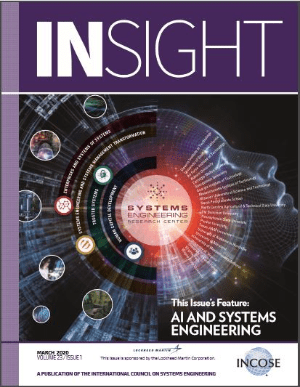
INSIGHT’s mission is to provide informative articles on advancing the state of the practice of systems engineering. The intent is to accelerate the dissemination of knowledge to close the gap between the state of practice and the state of research as captured in Systems Engineering, the Journal of INCOSE, also published by Wiley.
The March 2020 issue of INSIGHT addresses augmented and artificial intelligence (AI) for systems engineering (AI4SE) and systems engineering for augmented and artificial intelligence (SE4AI). SE4AI addresses the transformation we need in methods, procedures, and tools (MPTs) to engineer systems with embedded AI to be fit for purpose and doing no (unintended) harm. AI4SE addresses challenges that have to be overcome to leverage AI in the practice of systems engineering much as a lever or pulley provides mechanical advantage to perform work in Newtonian mechanics.
Tenets of systems engineering from control systems engineering are that engineered systems be observable, controllable (to assure system stability with tolerable errors), and identifiable. AI is in the forefront of technology advances with widely publicized innovations in image identification, diagnostics, and autonomy; AI applications gone awry are newsworthy in both the popular and scientific/engineering media.
AI methods can be broadly classed as rule-based and neural-network based. Rule-based methods are relatively mature with decades of experience in application and are well-understood. In contrast, much is unknown of the contextually driven behavioral characteristics of neural network-based AI, commonly referred to as machine learning and deep learning. Neural network performance is critically dependent on the datasets used to train the algorithms and whose actions currently cannot be guaranteed to be fit for purpose to meet the attributes of elegance that systems accomplish their intended purposes, be resilient to effects in real-world operation, while minimizing unintended actions, side effects, and consequences as described by Michael Griffin in his paper “How do we fix system engineering?” in 2010.
The articles represent ongoing research at the Systems Engineering Research Center (SERC), a university-affiliated research center (UARC) of the US Department of Defense, in addressing the AI4SE and SE4AI challenges as stated in their research roadmap for AI and autonomy (SERC 2019). The SERC (www.sercuarc.org), operated by Stevens Institute of Technology with the University of Southern California (USC) as principal collaborator, leverages the research and expertise of faculty and researchers from 22 collaborator universities throughout the US. The INSIGHT editorial staff and SERC theme editors Dinesh Verma, Tom McDermott, and Kara Pepe thank the authors for their contributions. The lead article by Tom McDermott, Dan DeLaurentis, Peter Beling, Mark Blackburn, and Mary Bone overviews the AI and autonomy research roadmap and maps the subsequent articles to the parts of the roadmap.
Articles contained within this edition:
- AI4SE and SE4AI: A Research Roadmap
- Knowledge Representation with Ontologies and Semantic Web Technologies to Promote Augmented and Artificial Intelligence in Systems Engineering
- As Smart as a Human? Leveraging Models of Human Intelligence to Assess the Intelligence of Systems
- Test and Evaluation for Artificial Intelligence
- Exploiting Augmented Intelligence in Systems Engineering and Engineered Systems
- Motivating a Systems Theory of AI
- A Systems Engineering Approach for Artificial Intelligence: Inspired by the VLSI Revolution of Mead & Conway
- Validation Testing of Autonomous Learning Systems
- AI as Systems Engineering Augmented Intelligence for Systems Engineers.
The SERC articles are within the scope of the systems community initiative on the future of systems engineering (FuSE) that has AI4SE and SE4AI as an initial project. The May 2019 issue of INSIGHT addressed other FuSE projects on systems engineering principles and foundations for systems engineering (F4SE). INSIGHT intends to report on FuSE related topics on an ongoing basis.
The editors of INSIGHT would be pleased to accept proposals from INCOSE chapters, working groups, and affiliated bodies for themed issues centered on systems engineering practices in 2021 and 2022. The remaining 2020 INSIGHT themes and articles are already committed: 1) Critical Infrastructure Protection and Recovery II follow-on to the December 2016 issue from the working group of the same name, 2) Security in Product Line Engineering from the Systems Security Engineering Group, and 3) Loss-Driven Systems Engineering from the Resilient Systems Working Group.
INSTRUCTIONS FOR VIEWING:
The entire issue of INSIGHT Volume 23, No. 1 is now available for viewing in the INCOSE Connect Library INSIGHT Practitioners Magazine.
INSIGHT Volume 23 No. 1 will be available later on the Wiley Online Library.
For information about INSIGHT, including upcoming issues, see https://www.incose.org/products-and-publications/periodicals#INSIGHT.
4.6 Online Tutorial: “Systems Engineering in the Context of a Product Life Cycle”
Saturday, June 27, 2020
8:30 AM – 1 PM Eastern Time USA
Abstract
In today’s hyper-complex world, full of uncertainty and great risks, it sometimes helps to step back and re-examine the basics. In this tutorial, Dr. Don Gelosh examines some of the fundamentals of systems engineering using the context of a product life cycle. The tutorial starts by looking at the overall importance of life cycle models, why we need them and some of their characteristics. Then the tutorial presents an overview of reliability, availability, maintainability and other necessary -ilities across the life cycle. The tutorial then provides a brief overview of Model-Based Systems Engineering, just enough to define it and discuss how to transition from the current paradigm to a future one. The second half of the tutorial focuses on the most important part of the life cycle: the systems engineers! The roles and competencies of systems engineers as defined by the International Council on Systems Engineering (INCOSE) are described followed by an examination of how systems engineers must also be leaders. The relationships among program managers, project managers, and technical lead systems engineers are then explored. The tutorial finishes with a brief overview of the INCOSE Systems Engineering Competency Framework.
Bio
 Dr. Don Gelosh is the Director of Systems Engineering Programs at Worcester Polytechnic Institute. Dr. Gelosh has over 44 years of experience including 26 years serving in the US Air Force and post-retirement work in government, industry, and academia. Before coming to WPI, Dr. Gelosh was Deputy Director for Workforce Development in the Office of Systems Engineering at the Pentagon, Dean of Learning and Technology at the National Defense University, Deputy Department Head at the Air Force Institute of Technology and a member of NASA’s Vehicle Integration and Test Team supporting the Space Shuttle. Dr. Gelosh holds a CSEP-Acquisition certification from INCOSE and is a member of the Washington Metro Area Chapter. Dr. Gelosh also serves on the INCOSE Board of Directors as the Services Director.
Dr. Don Gelosh is the Director of Systems Engineering Programs at Worcester Polytechnic Institute. Dr. Gelosh has over 44 years of experience including 26 years serving in the US Air Force and post-retirement work in government, industry, and academia. Before coming to WPI, Dr. Gelosh was Deputy Director for Workforce Development in the Office of Systems Engineering at the Pentagon, Dean of Learning and Technology at the National Defense University, Deputy Department Head at the Air Force Institute of Technology and a member of NASA’s Vehicle Integration and Test Team supporting the Space Shuttle. Dr. Gelosh holds a CSEP-Acquisition certification from INCOSE and is a member of the Washington Metro Area Chapter. Dr. Gelosh also serves on the INCOSE Board of Directors as the Services Director.
5.1 The QFD Institute
Quality function deployment (QFD) is a method developed in Japan beginning in 1966 to help transform the voice of the customer into engineering characteristics for a product. Yoji Akao, the original developer, described QFD as a “method to transform qualitative user demands into quantitative parameters, to deploy the functions forming quality, and to deploy methods for achieving the design quality into subsystems and component parts, and ultimately to specific elements of the manufacturing process.” The author combined his work in quality assurance and quality control points with function deployment used in value engineering.
The QFD Institute was founded in 1993 by Glenn H. Mazur, John Termko, and Richard Zultner to research and develop state-of-the-art methods, tools, and training. It is the only dedicated QFD institution in the world. The QFD Institute is the oldest dedicated QFD and ISO 1633 education and research organization in the world.
Among services and activities provided by the QFD Institute are:
- Research in leading-edge QFD, design and quality concepts, and relevant methodologies;
- Research in the state-of-art QFD teaching methods including presentation of the most up-to-date best QFD practices and tools;
- Leadership and body of knowledge contributions to the ISO 16355 standard for QFD and new product development;
- QFD training of all proficiency certificate levels including development of custom-tailored QFD processes and in-house training, as well as Public QFD Courses;
- Workshops and tutorials on relevant methods at non-certificate levels;
- Public presentation of QFD best practice at domestic and international symposia, publications, and collaboration with the International Council on QFD; and
- Administration of the Akao Prize®.
5.2 International Council for Quality Function Deployment
The International Council for Quality Function Deployment (ICQFD) was established at the conclusion of the 3rd International Symposium on QFD in 1997. The purpose of the ICQFD is to provide a unified body to coordinate the many local QFD organizations, efforts, and events around the world. It provides a single window to these activities to QFD practitioners.
The Council is composed of member organizations who represent their respective country in terms of coordinating and hosting QFD events in their region, such as the International Symposium on QFD (ISQFD). This is done in close cooperation with the ICQFD and with approval from the Council.
The Council meets at annual International QFD Symposiums. Meeting invitations are extended to those who have demonstrated commitment and service to building their national QFD community.
5.3 The Center for Learning with Nature
Engineering Inspired by Nature is a fascinating, solution-oriented, cutting-edge curriculum to teach engineering and design. A project-based approach to creative problem-solving, students along the way learn fundamentals and modern methods used by engineering and design professionals in material science, structural and mechanical engineering, product design, manufacturing, energy, computer science, medical technology, architecture, urban design, and more… and they learn it in a way that leaves them energized and inspired.
6. News on Software ToolS Supporting
Systems Engineering
-
- Vitech Releases GENESYS™ 2020
GENESYS provides tools for all phases of model-based systems engineering to:
- Collect, import, and manage requirements
- Examine use cases, define system behavior, and perform functional analysis
- Create and modify architectures
- Test models with on-board simulation enabling virtual prototyping from the earliest stages of system definition
- Use pre-populated templates to generate industry standard documentation or create your own reports with drag-drop simplicity
6.2 OMG Technical Meeting Overview
June 22-26, 2020 (Virtual Meeting)
The OMG Technical Meeting provides IT architects, business analysts, government experts, vendors and end-users a neutral forum to discuss, develop and adopt standards that enable software interoperability for a wide range of industries. Attend an OMG Technical Meeting to influence the direction of future standards work, hear from industry experts, network with your peers and be among the first to know what will be cutting edge tomorrow.
Special events:
Meeting fees:
The Q2 Virtual TC Meeting is complimentary for OMG Members. With proper approvals, non-members are invited to attend and are required to pay the virtual meeting registration fee of USD $295.00 to participate in the meeting week activities.
Participants:
OMG Technical Meetings attract up to 500 technology representatives and industry leaders from member organizations.
Participants include: Chief Operating Executives, Chief Information Officers, Chief Technology Officers, Software Architects, System Architects, Enterprise Architects, Research Scientists, Software Engineers, Software Developers, IT Managers, IT Executives, Consultants.
Meeting overview:
Sunday – Thursday: Throughout the meeting week, up to 25 parallel subgroup meetings are held. These subgroup meetings are working meetings which focus on the development of software standards in the domain and platform technology areas. Domain areas include, but are not limited to Finance, Manufacturing, Space, Telecomm and Life Sciences. Platform technologies represented are Model Driven Architecture® (MDA®), UML®, CORBA®, CWM™, Security and more.
Wednesday: Presentation(s) by select sponsoring organization(s) made during a plenary session. The presentation(s) is(are) technological or strategic in nature.
Tuesday & Wednesday: An exhibit area is open for viewing demonstrations of OMG technology-based products.
Friday: The meeting week concludes with an Architectural Board (AB) Domain (DTC) and Platform Technology Committee (PTC) Plenary. At this meeting, representatives of member organizations with voting privileges recommend adoption of specifications. This is the culmination of member involvement in the OMG Technology Adoption Process.
7. Systems Engineering Publications
7.1 Human Factors in Simple and Complex Systems
by
Robert W. Proctor and Trisha Van Zandt
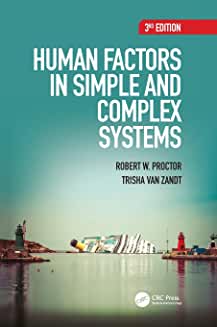
From the Amazon.com Website:
Recently, there have been a number of advances in technology, including in mobile devices, globalization of companies, display technologies and healthcare, all of which require significant input and evaluation from human factors specialists. Accordingly, this textbook has been completely updated, with some chapters folded into other chapters and new chapters added where needed. The text continues to fill the need for a textbook that bridges the gap between the conceptual and empirical foundations of the field.
From a review:
“Proctor and Van Zandt are polymaths who’ve written a rigorous and practical introduction to human factors. Early chapters survey the field’s history and systems of thought. Later chapters cover the principles of cognitive, physical, and organizational ergonomics, and the real-world practice of human factors engineering. The book’s multidisciplinary attitude means that students from any academic background will find something novel and stimulating in the material, and that all will take away a thorough knowledge of human factors and ergonomics.”
― Jason McCarley, Oregon State University, USA
Publisher: CRC Press; 3rd edition (December 26, 2017)
Format: Hardcover
ISBN-10: 1482229560
ISBN-13: 978-1482229561
7.2 A Framework for Making Better Infrastructure Decisions
by
Aaron Bielenberg, James Williams, and Jonathan Woetzel
McKinsey & Company
Best practices can help governments invest in infrastructure that expands the economy and better serve the public.
Infrastructure – for example, transportation, power, water, and telecom systems – underpins economic activity and catalyzes growth and development. The world spends more than $2.5 trillion a year on infrastructure, but $3.7 trillion a year will be needed through 2035 just to keep pace with projected GDP growth. National, state, and local governments are devoting increased amounts of capital to meet these needs, and for good reason. The McKinsey Global Institute estimates that infrastructure has a socioeconomic rate of return around 20 percent. In other words, $1 of infrastructure investment can raise GDP by 20 cents in the long run.
Gains from infrastructure are fully realized, however, only when projects generate tangible public benefits. Unfortunately, many governments find it difficult to select the right projects—those with the most benefit. Furthermore, infrastructure can provide social and economic advantages only when the capital and operating costs can be financed sustainably, either by the revenues a project generates or by the government sponsor. Too many projects become an economic burden and drain on finances when a government borrows money for an undertaking and neither its revenues nor its direct and indirect economic benefits adequately cover the cost.
7.3 Exploring Engineering: An Introduction to Engineering and Design
by
Philip Kosky, Robert T. Balmer, William D. Keat, and George Wise
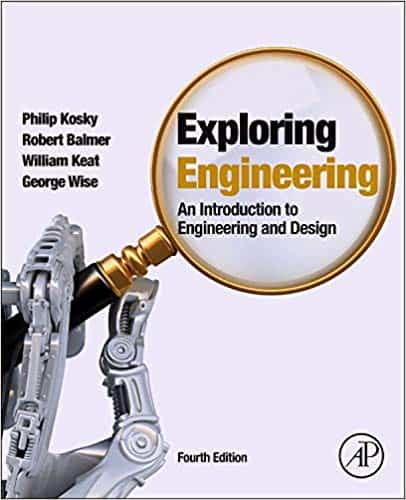
From the Amazon.com Website:
Exploring Engineering: An Introduction to Engineering and Design, presents the emerging challenges engineers face in a wide range of areas as they work to help improve our quality of life. In this classic textbook, the authors explain what engineers actually do, from the fundamental principles that form the basis of their work to the application of that knowledge within a structured design process. The text itself is organized into three parts: Lead On, Minds On, Hands On. This organization allows the authors to give a basic introduction to engineering methods, then show the application of these principles and methods, and finally present a design challenge. This book is an ideal introduction for anyone interested in exploring the various fields of engineering and learning how engineers work to solve problems.
- New: Chapters on Aeronautical Engineering, Industrial Engineering, and Design Teams
- New: Expanded content in the chapters “Defining the Problem,” “Generation of ‘Alternative Concepts’,” and “Detailed Design”
- New: Material on sustainability issues in engineering
- Introduces students to the engineering profession, emphasizing the fundamental physical, chemical, and material bases for all engineering work
- Includes an Engineering Ethics Decision Matrix used throughout the book to pose ethical challenges and explore decision making in an engineering context
- Lists of “Top Engineering Achievements” and “Top Engineering Challenges” help put the material in context and show engineering as a vibrant discipline involved in solving societal problems
- Companion Web site includes links to several new drawing supplements, including “Free hand Engineering Sketching,” (detailed instructions on free hand engineering sketching); “AutoCAD Introduction,” (an introduction to the free AutoCAD drawing software); and “Design Projects,” (new freshman level design projects that complement the “Hands On” part of the textbook).
Publisher: Academic Press; 4 edition (July 9, 2015)
Format: eTextbook, Hardcover
ISBN-10: 0128012420
ISBN-13: 978-0128012420
ISBN-13: 978-0128012420
More Information
7.4 Engineering Education for the Next Generation:
A Nature-Inspired Approach
by
Samuel Cord Stier
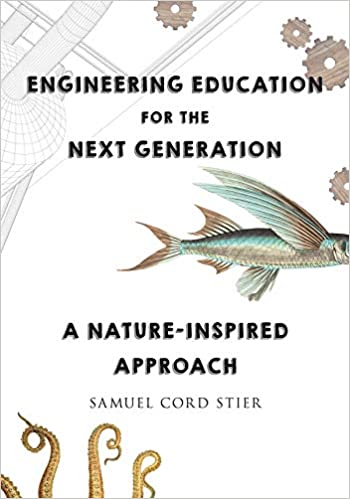
This practical book demonstrates how engineering design is relevant for all students, not just those who may become scientists or engineers. Mr. Stier describes clever, engaging activities for students at every grade level to grasp engineering concepts by exploring the everyday design genius of the natural world around us. Students will love learning about structural engineering while standing on eggs; investigating concepts in sustainable design by manufacturing cement out of car exhaust; and coming to understand how ant behavior has revolutionized the way computer programs, robots, movies, and video games are designed today. You will come away with an understanding of engineering and nature unlike any you’ve had before, while taking your ability to engage students to a whole new level.
Engineering Education for the Next Generation is a wonderful introduction to the topic for any teacher who wants to understand more about engineering design, its relation to the larger subjects of STEM/STEAM, and how to engage students from all backgrounds in a way that meaningfully transforms their outlook on the world and their own creativity in a lifelong way.
- Fun to read, comprehensive exploration of cutting-edge approaches to K-12 engineering education.
- Detailed descriptions and explanations to help teachers create activities and lessons.
- An emphasis on engaging students with broad and diverse interests and backgrounds.
- Insights from a leading, award-winning K-12 engineering curriculum that has reached thousands of teachers and students in the U.S. and beyond.
- Additional support website (www.LearningWithNature.org) providing more background, videos, curricula, slide decks, and other supplemental materials.
Publisher: W. W. Norton & Company; 1 edition (March 10, 2020)
Format: Kindle, Paperback
ISBN-10: 0393713776
ISBN-13: 978-0393713770
7.5 Strategies for Creative Problem Solving (3rd Ed)
by
H. Scott Fogler and Steven E. LeBlanc
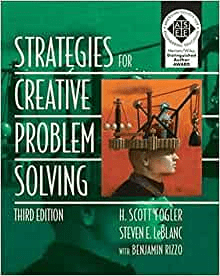
From the Amazon.com Website:
This book will help you hone your creative skills and apply those skills to solve nearly any problem. Drawing on National Science Foundation-funded, advanced research that studied problem-solving techniques in all areas of modern industry, this book presents a comprehensive, systematic problem-solving framework. Through hands-on techniques and exercises drawing on realistic examples, you will learn how to approach an ill-defined problem, identify the real problem, generate and implement the best solution, evaluate what you’ve learned, and build on that knowledge.
This third edition has been updated and revised, further enhancing its value for engineers, technical practitioners, students, and anyone who wants to improve their problem-solving skills. Updates include:
- More than twenty-five new examples–based on recent, real-world events and topics–that illustrate the various problem-solving techniques
- Expanded coverage of critical thinking and reasoning
- An introduction to structured critical reasoning
- New discussion of managing complex change
- Expanded and improved explanations of the components of problem-solving strategies
The first edition of this book earned ASEE’s 1996 Meriam-Wiley Distinguished Author Award, and now it’s more focused and useful than ever.
Publisher: Prentice Hall; 3 edition (October 18, 2013)
Format: Paperback
ISBN-10: 013309166X
ISBN-13: 978-0133091663
7.6 97 Things Every Engineering Manager Should Know:
Collective Wisdom from the Experts
by
Camille Fournier
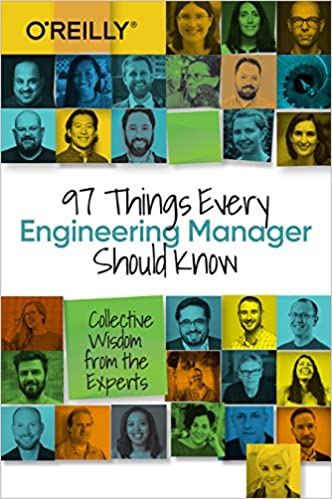
From the Amazon.com Website:
Tap into the wisdom of experts to learn what every engineering manager should know. With 97 short and extremely useful tips for engineering managers, you’ll discover new approaches to old problems, pick up road-tested best practices, and hone your management skills through sound advice.
Managing people is hard, and the industry as a whole is bad at it. Many managers lack the experience, training, tools, texts, and frameworks to do it well. From mentoring interns to working in senior management, this book will take you through the stages of management and provide actionable advice on how to approach the obstacles you’ll encounter as a technical manager.
A few of the 97 things you should know:
- “Three Ways to Be the Manager Your Report Needs” by Duretti Hirpa
- “The First Two Questions to Ask When Your Team Is Struggling” by Cate Huston
- “Fire Them!” by Mike Fisher
- “The 5 Whys of Organizational Design” by Kellan Elliott-McCrea
- “Career Conversations” by Raquel Vélez
- “Using 6-Page Documents to Close Decisions” by Ian Nowland
- “Ground Rules in Meetings” by Lara Hogan
Publisher: O’Reilly Media; 1 edition (November 21, 2019)
Format: Kindle, Paperback
ASIN: B081TPX6NS
7.7 The Manager’s Path: A Guide for Tech Leaders Navigating Growth and Change
by
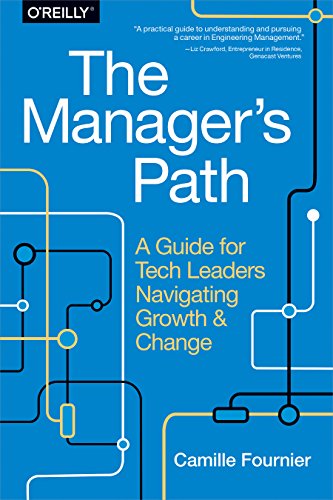
From the Amazon.com Website:
Managing people is difficult wherever you work. But in the tech industry, where management is also a technical discipline, the learning curve can be brutal—especially when there are few tools, texts, and frameworks to help you. In this practical guide, author Camille Fournier (tech lead turned CTO) takes you through each stage in the journey from engineer to technical manager.
From mentoring interns to working with senior staff, you’ll get actionable advice for approaching various obstacles in your path. This book is ideal whether you’re a new manager, a mentor, or a more experienced leader looking for fresh advice. Pick up this book and learn how to become a better manager and leader in your organization.
- Begin by exploring what you expect from a manager
- Understand what it takes to be a good mentor, and a good tech lead
- Learn how to manage individual members while remaining focused on the entire team
- Understand how to manage yourself and avoid common pitfalls that challenge many leaders
- Manage multiple teams and learn how to manage managers
- Learn how to build and bootstrap a unifying culture in teams
Publisher: O’Reilly Media; 1 edition (March 13, 2017)
Format: Kindle, Audiobook, Paperback
ASIN: B06XP3GJ7F
8.1 Industrial Systems Engineering
International University of Logistics and Transport in Wroclaw, Poland
Description of the specialization
Students will acquire specialist knowledge in the field of logistics systems optimization in production and industrial companies, as well as skills that will enable them to manage, control quality and optimize production. The courses allow students to acquire knowledge required to design and manage logistics and production systems as far as technology, economy, organization and knowledge of society are concerned. These studies also focus on practical skills that combine technological, economic, and organizational aspects of production logistics. Moreover, the courses allow to educate professionals who are prepared to perform managerial tasks in research projects dedicated to industrial development. The curriculum has been adjusted to teaching standards at the University of Lorraine.
8.2 Bachelor of Engineering in Data and Systems Engineering
University of Hong Kong
This major aims at equipping students with strong analytical and decision-making skills in analyzing, managing, and improving nowadays enterprise-class systems via offering solid disciplines in data science and intelligent systems. An enterprise under consideration can mean an engineering, business, governmental, or service-oriented organization. The targets of management and improvement can be the strategies, operations and supply chain of an enterprise, and the products and services offered by an enterprise. A BENG DSE student is nurtured to become an analytical and versatile graduate, competent in collecting, analyzing and interpreting large data and transforming the massive information into relevant insights for making better decisions in his or her organization.
Intended Learning Outcomes of Major (MILOs)
Upon successful completion of this major, students should be able to:
- Apply knowledge of mathematics, science and engineering into analyzing and improving enterprises systems.
- Design and conduct experiments, and analyze and interpret data that are relevant to processes including operations, marketing, finance, supply chain, etc. in the enterprise system.
- Design processes, systems, products and services to meet desired needs within realistic constraints such as market, economics, technology, environment and sustainability.
- Function effectively and responsibly in multi-disciplinary teams.
- Identify, evaluate, formulate, solve problems relevant to the operations, logistics, finance, supply chain in an enterprise, and undertake projects of discovery and innovation.
- Understand professional and ethical responsibility.
- Communicate effectively.
- Have knowledge in contemporary issues and an awareness of the impact of engineering and management solutions in a broad, global and societal context.
- Recognize the need for, and an ability to engage in life-long learning.
- Use necessary data science, engineering, and IT skills and tools for engineering and management practice, discovery and innovation.
8.3 Find the right Masters of Systems Engineering Program for You
Developing the advanced engineering skills you need is critical to your job performance and your career. Find the right Masters of Systems Engineering degree for you with engineering.com. How it works:
From engineering.com:

Visit the site here.
9. Some Systems Engineering-Relevant Websites
Discussion Thread: Why does systems thinking not succeed in meeting professionals’ expectations from it?
Systems thinking has been quite appealing to academia and industry folks for quite some time now. Many people believe System thinking has not lived up to the expectations. What are the possible causes of its failure and what can be done to make systems thinking an effective problem solving tool? Is it time to propose a new paradigm to understand and solve new age problems?
Strategies for Creative Problem Solving
A book by this same name was highlighted in the SE Publications section, above – the companion website is a valuable resource for students and instructors. The site contains:
- Interactive Computer Modules: Seven simulations linked to the book’s content and designed to deepen your expertise with every stage of the problem-solving process.
- Summary Notes: Chapter-specific material that highlights important points in each chapter–excellent for classroom presentations and concept review.
- Professional Reference Shelf: Additional examples and problem-solving materials.
- Additional Study Materials: Course syllabi and Web links to related material.
Introduction to the fundamentals of model-based systems engineering
Growing systems complexity requires the implementation of new development methods to keep costs, effort, and quality under control. Traditional, document-centric and test-based approaches are not compatible with current multi-disciplinary and distributed system engineering. Model-based systems engineering (MBSE) addresses this complexity with a model-centric, frontloaded engineering methodology.
This on-demand webinar addresses the fundamental concepts of model-based systems engineering, benefits, and typical use cases.
With this webinar, you will learn some best practices to establish model-based systems engineering, as well as information concerning appropriate tools and methodologies.
https://www.plm.automation.siemens.com/global/en/webinar/model-based-systems-engineering/26111
INCOSE’s Systems Engineering Certification Levels
The Certification Program offers the Associate Systems Engineering Professional (ASEP) that recognizes individuals who wish to be recognized as knowledgeable but without demonstrated SE experience. The qualification for the ASEP is possession of SE knowledge typical of a junior systems engineering practitioner, as evidenced by passing the knowledge exam.
The Certified Systems Engineering Professional (CSEP) recognizes systems engineering practitioners who have demonstrated knowledge and experience in many aspects of the discipline. The qualifications for this level include education, SE knowledge, and SE experience that serve various job profiles of an experienced, all-round systems engineer.
The Expert Systems Engineering Professional (ESEP) certification is for those system engineers who have distinguished themselves by demonstrating both substantial experience and technical leadership. The ESEP has a broader and deeper experience in performing and leading systems engineering than the CSEP. The ESEP has at least twenty years of systems engineering experience and is the person others seek with specific, challenging, technical questions. He or she is not an expert in all aspects of systems engineering but is the expert for some aspects of SE and could perform adequately in many.
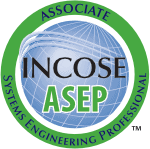
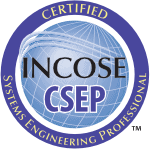
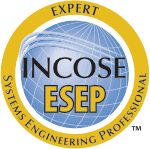
Find out more about the INCOSE certification page
https://www.incose.org/systems-engineering-certification/Certification-Levels
Certification Training International, a subsidiary company of PPI, offers INCOSE SEP Exam Prep training to help you take the INCOSE exam comfortably and apply the knowledge of the handbook to the context of your organizational environment.
For more information about our upcoming INCOSE SEP Exam Courses, please visit
https://certificationtraining-int.com/incose-sep-exam-prep-course/
The EngineerGirl
The EngineerGirl website is designed to bring attention to the exciting opportunities that engineering represents for girls and women.
From the website:
Why girls and women? Because despite an increase in female participation in many traditionally male-dominated professions such as medicine and law, women remain grossly under-represented in engineering. Engineering and engineers are central to the process of innovation, and innovation drives economic growth. Diversity of thought is crucial to creativity, and by leaving women out of the process of innovation we lose a key component of diversity and stifle innovation. We want the creative problem-solvers of tomorrow to fully represent the world’s population, because they will be the ones to ensure our health, happiness, and safety in years to come.
Follow the link below to find out how you can get involved in this initiative:
10.1 ISO 16355 Quality Function Deployment
ISO 16355 is a standard that consolidates methods used in quality function deployment (QFD), and other statistical methods and tools used in product development. Glenn Mazur, Executive Director of the QFD Institute and International Council for QFD, explains how this standard can help organizations better align resources and discusses best practices in QFD in a video available here.
10.2 ISO/IEC/IEEE 21839:2019
Systems and software engineering — System of systems (SoS) considerations in life cycle stages of a system
This document provides a set of critical system of systems (SoS) considerations to be addressed at key points in the life cycle of the system of interest (SoI). This document refers to considerations that apply to an SoI that is a constituent system that interacts in an SoS. The considerations and life cycle model align with those which are already defined in ISO/IEC/IEEE 15288 and ISO/IEC/IEEE 24748-1. Selected subsets of these considerations can be applied throughout the life of systems through the involvement of stakeholders. The ultimate goal is to achieve customer satisfaction, so that when delivered, the SoI will operate effectively in the operational or business environment which is typically characterized as one or more systems of systems.
11. Some definitions to close on
11.1 Quality Function Deployment
Quality function deployment is a method and a set of tools developed in Japan beginning in 1966 to help transform the voice of the customer into engineering characteristics for a product. It is a structured approach to defining customer needs or requirements and translating them into specific plans to produce products to meet those needs. QFD provides documentation for the decision-making process. QFD helps to prioritize possible offering specifications and make trade-off decisions based on weighted customer requirements and ranked competitive assessment.
Source: Wikipedia
11.2 Configuration Management
Configuration management (CM) is a systems engineering process for establishing and maintaining consistency of a product’s performance, functional, and physical attributes with its requirements, design, and operational information throughout its life. The CM process is widely used by military engineering organizations to manage changes throughout the system lifecycle of complex systems, such as weapon systems, military vehicles, and information systems.
Source: Wikipedia
11.3 Duncker Diagrams
The Duncker diagram facilitates obtaining solutions that satisfy the present state/ desired state statements.
The unique feature of the Duncker diagram is that it contains two major pathways (general solutions) to go from the present state (the problem statement) to the desired state (an acceptable problem solution).
An example Duncker diagram:
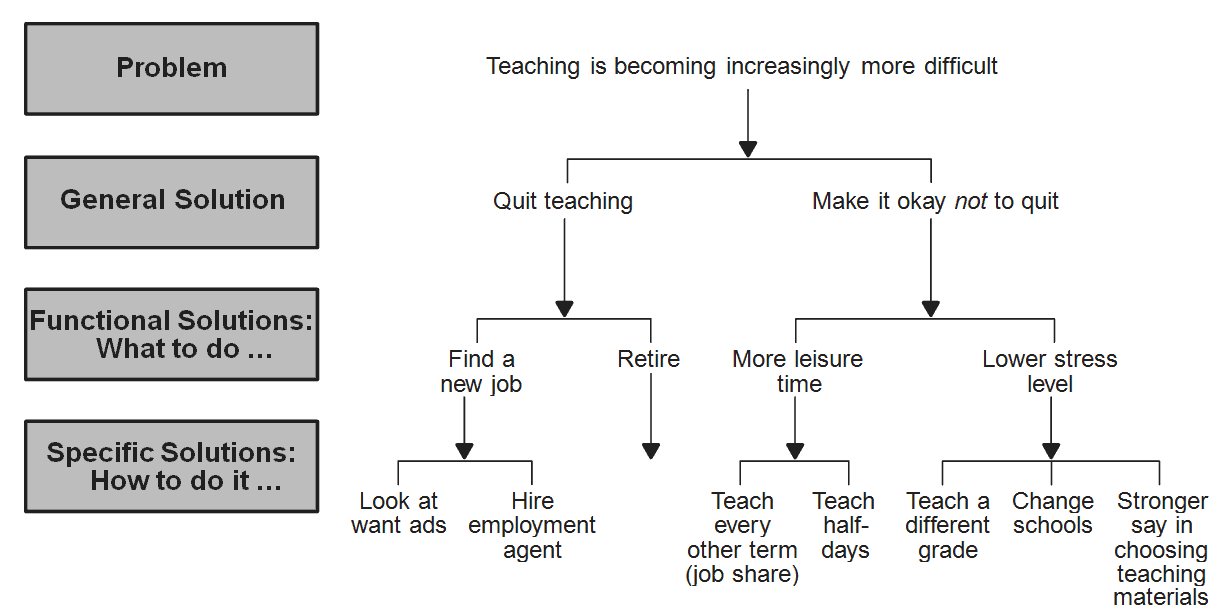
Source: Strategies for Creative Problem Solving Website
For more information on systems engineering related conferences and meetings, please go to our website.
The featured event for this edition is:
IEEE Technology Engineering Management Society International Virtual Conference (TEMSON)
June 3rd – 6th, 2020
TEMSCON 2020 Topics
- Innovating in rapidly changing markets, e.g. biotech and health care and manufacturing
- Leading and managing innovation and transformation
- Adopting new technologies: challenges and risk mitigation
- Managing in-vehicle software versions and interoperability among the different vehicle ages & brands
- Understanding trends and applicability of new technologies
- Leveraging enterprise data, e.g., successful use of AI, analytics, blockchain and IoT
- Leading societal change, e.g., mobility, intelligent transportation, healthcare and public policy
- Enhancing industry, university, and/or government collaboration
- Developing personal skills for leading innovation initiatives
Find out more here
13.1 Introducing PPI Live-Online™
March and April have been a big months, with the launch of PPI’s new, live online training service PPI Live-Online™ to our clients. Not only a launch, but successful public and in-house deliveries of six online courses on five continents, the largest being a group of 27 participants! And under its own new PPI Live-Online™ branding (see below).
All PPI training that was previously available only by physical delivery is now also available through PPI Live-Online™. See https://www.ppi-int.com/on-site-training/
PPI Managing Director Robert Halligan said this week “We believe that the world has changed forever. PPI continues its leadership in delivering value to its clients via systems engineering training worldwide with the introduction of PPI Live-Online™. PPI Live-Online and its benefits to clients of PPI in terms of outstanding content, expert facilitators, flexibility, economy and avoidance of travel are here to stay.”

Systems Engineering

This world-renowned course, already delivered to over 11,000 professionals in 40 countries, provides a proven-effective set of technical and management principles and practices that integrate to reduce time and cost, delight stakeholders, and reduce risk in technical projects. Systems engineering delivers benefit regardless of domain, project size and technologies.
Upcoming courses:
01 – 05 Jun, 2020 | Oceania UTC +10:00 (AEST 8:00)
15 – 19 Jun, 2020 | North America UTC -4:00 (EDT 8:00)
22 – 26 Jun, 2020 | United Kingdom UTC +1:00 (BST 8:00)
22 – 26 Jun, 2020 | Europe UTC +2:00 (CEST 9:00)
06 – 10 Jul, 2020 | South Africa UTC +2:00 (SAST 8:00)
17 – 21 Aug, 2020 | South America UTC -3:00 (BRT 9:00)
31 Aug – 04 Sep, 2020 | Asia UTC +8:00 (SGT 9:00)
31 Aug – 04 Sep, 2020 | North America UTC -6:00 (EDT 8:00)
14 – 18 Sep, 2020 | Europe UTC +2:00 (CEST 9:00)
14 – 18 Sep, 2020 | United Kingdom UTC +1:00 (BST 8:00)
28 Sep – 02 Oct, 2020 | Oceania UTC +10:00 (AEST 8:00)
Requirements Analysis & Specification Writing
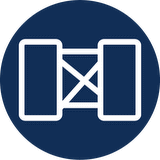
Requirements Analysis and Specification Writing are sciences practiced by many, mastered by surprisingly few. Yet the payoff from achieving excellence in these areas is large indeed. Upon completion of training, participants will have an understanding of how to effectively capture and validate requirements, write good requirements and appropriately structure requirements specifications for maximum usability.
Upcoming courses:
29 Jun – 03 Jul, 2020 | Turkey UTC +3:00 (TRT 8:00)
03 – 07 Aug, 2020 | Oceania UTC +10:00 (AEST 9:00)
03 – 07 Aug, 2020 | South Africa UTC +2:00 (SAST 8:00)
17 – 21 Aug, 2020 | Oceania UTC +10:00 (AEST 8:00)
24 – 28 Aug, 2020 | Asia UTC +8:00 (SGT 9:00)
Systems Engineering Management
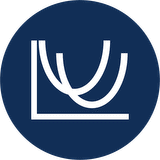
This course provides in-depth coverage of how to manage engineering projects to maximize project success, within the project’s given constraints. The course establishes principles and provides methods for successfully managing risk inherent in the technical program, and for getting the best out of people, individually and in teams.
Upcoming courses:
15 – 19 Jun 2020 | United Kingdom UTC +1:00 (BST 8:00)
15 – 19 Jun 2020 | Europe UTC +2:00 (CEST 9:00)
15 – 19 Jun 2020 | Oceania UTC +10:00 (AEST 8:00)
07 – 11 Sep 2020 | United Kingdom UTC +1:00 (BST 8:00)
07 – 11 Sep 2020 | Europe UTC +2:00 (CEST 9:00)
14 – 18 Sep 2020 | South Africa UTC +2:00 (SAST 8:00)
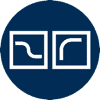
Requirements, OCD & CONOPS in Military Capability Development
This course is a 5-day immersion in the development of military capability, with a focus on problem definition, and concept of operations (how the military outcome is to be achieved). The course, easily migrated to other application domains, confronts the reasons for many large project failures. Delegates receive a library of example work products for a submarine SAR problem and solution.
Upcoming courses:
25 – 29 May 2020 | Europe UTC +2:00 (CEST 9:00)
25 – 29 May 2020 | South Africa UTC +2:00 (SAST 9:00)
25 – 29 May 2020 | United Kingdom UTC +1:00 (BST 8:00)
06 – 10 Jul 2020 | South America UTC -03:00 (BRT 9:00)
21 – 25 Sep 2020 | North America UTC -4:00 (EDT 8:00)
Architectural Design
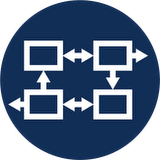
This course addresses the principles and methods of designing, regardless of what is being designed. The training is strong in Model-Based Systems Engineering (MBSE) methods supported by substantial workshop activity and provides insight into the realities of current modelling languages and tools, and the directions in which model-based design is evolving. Delegates learn how to perform techniques of development of physical solution, supporting development of logical solution, evaluation of solution alternatives (trade-off studies) and design iteration. We also provide introductory coverage of the disciplines of reliability engineering, safety engineering, maintainability engineering and producibility engineering.
Upcoming courses:
13 – 17 Jul 2020 | South America UTC -3:00 (BRT 8:00)
17 – 21 Aug 2020 | South Africa UTC +2:00 (SAST 8:00)
07 – 11 Sep 2020 | Europe UTC +2:00 (CEST 9:00)
07 – 11 Sep 2020 | United Kingdom UTC +1:00 (BST 8:00)
13.2 Introducing CTI Live-Online™ Course
CTI’s INCOSE SEP Prep Exam Course – everything you need to know to pass the INCOSE Knowledge Exam!
With CTI Live-Online™ delivery, you will gain access to our premium INCOSE Knowledge exam preparation course from the comfort of your own home or office. This is achieved by maintaining a combination of high-quality course materials, expert instruction and significant interaction among all participants to make the learning process effective and enjoyable!
Over the course of 4 days, led by an experienced and qualified facilitator, you will be taken on an immersive journey into the INCOSE Systems Engineering Handbook V4 (SEH). CTI Live-Online™ brings the SEH to life in such a way that you are well placed to pass the exam on your first attempt* and so that you may apply concepts of the Handbook to your engineering work.
Your success is our priority!
*If you don’t pass the exam on your first attempt, you are welcome to join in on another CTI Live-Online™ course of your choice at no charge.
Upcoming courses:
25 – 28 May 2020 | United Kingdom UTC +1:00 (BST 8:00)
25 – 28 May 2020 | Europe UTC +2:00 (CEST 9:00)
25 – 28 May 2020 | South Africa UTC +2:00 (CEST 9:00)
01 – 04 June 2020 | North America UTC -6:00 (EDT 8:00)
24 – 27 Aug 2020 | Oceania UTC +10:00 (AEST 8:00)
13.3 PPI/CTI and Covid-19
The world has changed a lot since publication of the last edition of SyEN. More than anything else, we wish SyEN readers health and safety in this era of Covid-19.
For our part, all PPI family members are now working from home. We are still going strong, doing our bit to try and keep the world moving. We have introduced PPI Live-Online™ and CTI Live-Online™, for live online delivery of all PPI and CTI training courses to home and office, we continue to help clients harness the power of systems engineering with our consulting services, and an outstanding (we believe) engineering management Webinar series is in the works.
Some public courses are still scheduled for physical delivery from July onwards in small regional areas. Such deliveries will only take place in accordance with strict government guidelines and when restrictions are safely lifted. We will not compromise the health and safety of our training participants or our facilitators. Limited on-site physical deliveries may also be possible in some locations under similarly stringent conditions.
For a full public PPI Live-Online™ training course schedule, please visit https://www.ppi-int.com/ppi-live-online/
For a full public PPI training course schedule, please visit https://www.ppi-int.com/course-schedule/
For a full public CTI Live-Online™ INCOSE SEP Exam Preparation course schedule, please visit https://certificationtraining-int.com/incose-sep-exam-prep-course/
To enquire about CTI Live-Online™ INCOSE SEP Exam Preparation Training for your organization, please visit https://certificationtraining-int.com/on-site-training/
15. Upcoming PPI Participation in Professional Conferences
PPI will be participating physically in the following upcoming events. We support the events that we are sponsoring, and look forward to meeting old friends and making new friends at the events at which we will be exhibiting.
The INCOSE International Workshop 2021
Date: 29 – 31 January, 2021
Location: Seville, Spain
Kind regards from the PPI SyEN team:
Robert Halligan, Editor-in-Chief, email: rhalligan@ppi-int.com
Ralph Young, Editor, email: ryoung@ppi-int.com
René King, Managing Editor, email: rking@ppi-int.com
Project Performance International
2 Parkgate Drive, Ringwood, Vic 3134 Australia
Tel: +61 3 9876 7345
Fax: +61 3 9876 2664
Tel Brasil: +55 12 9 9780 3490
Tel UK: +44 20 3608 6754
Tel USA: +1 888 772 5174
Tel China: +86 188 5117 2867
Web: www.ppi-int.com
Email: contact@ppi-int.com
Copyright 2012-2020 Project Performance (Australia) Pty Ltd, trading as
Project Performance International
Tell us what you think of PPI SyEN. Email us at syen@ppi-int.info.


